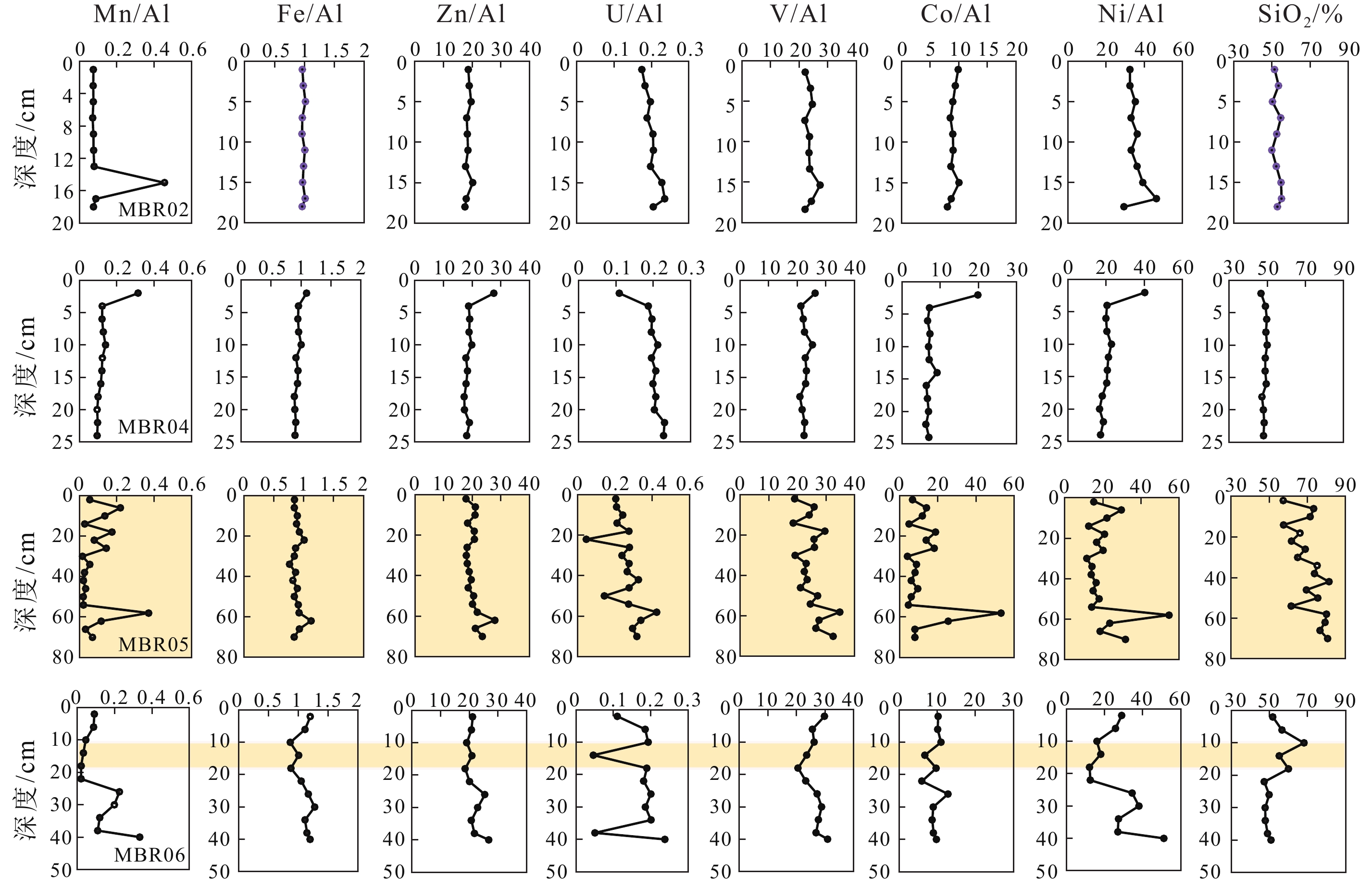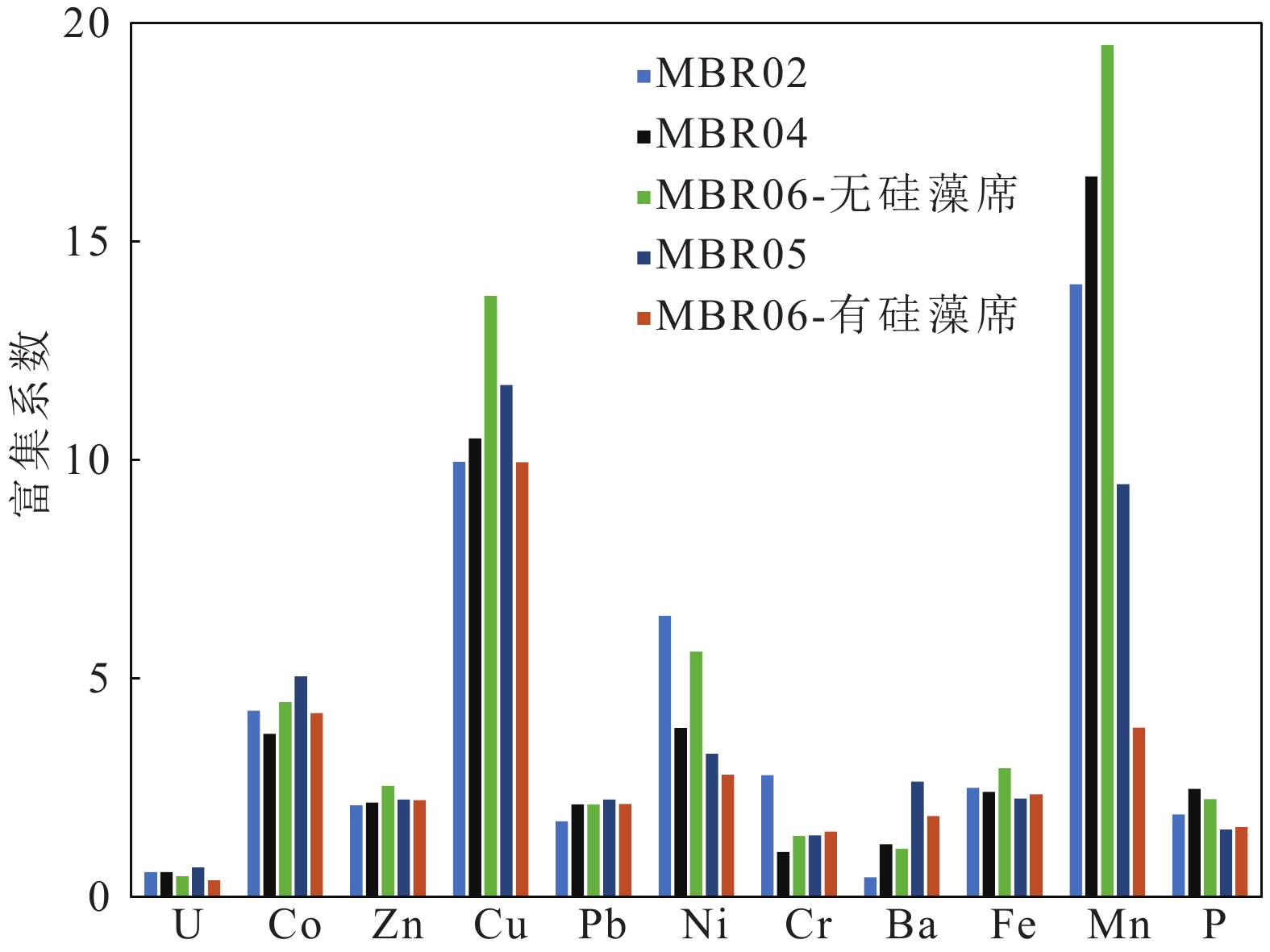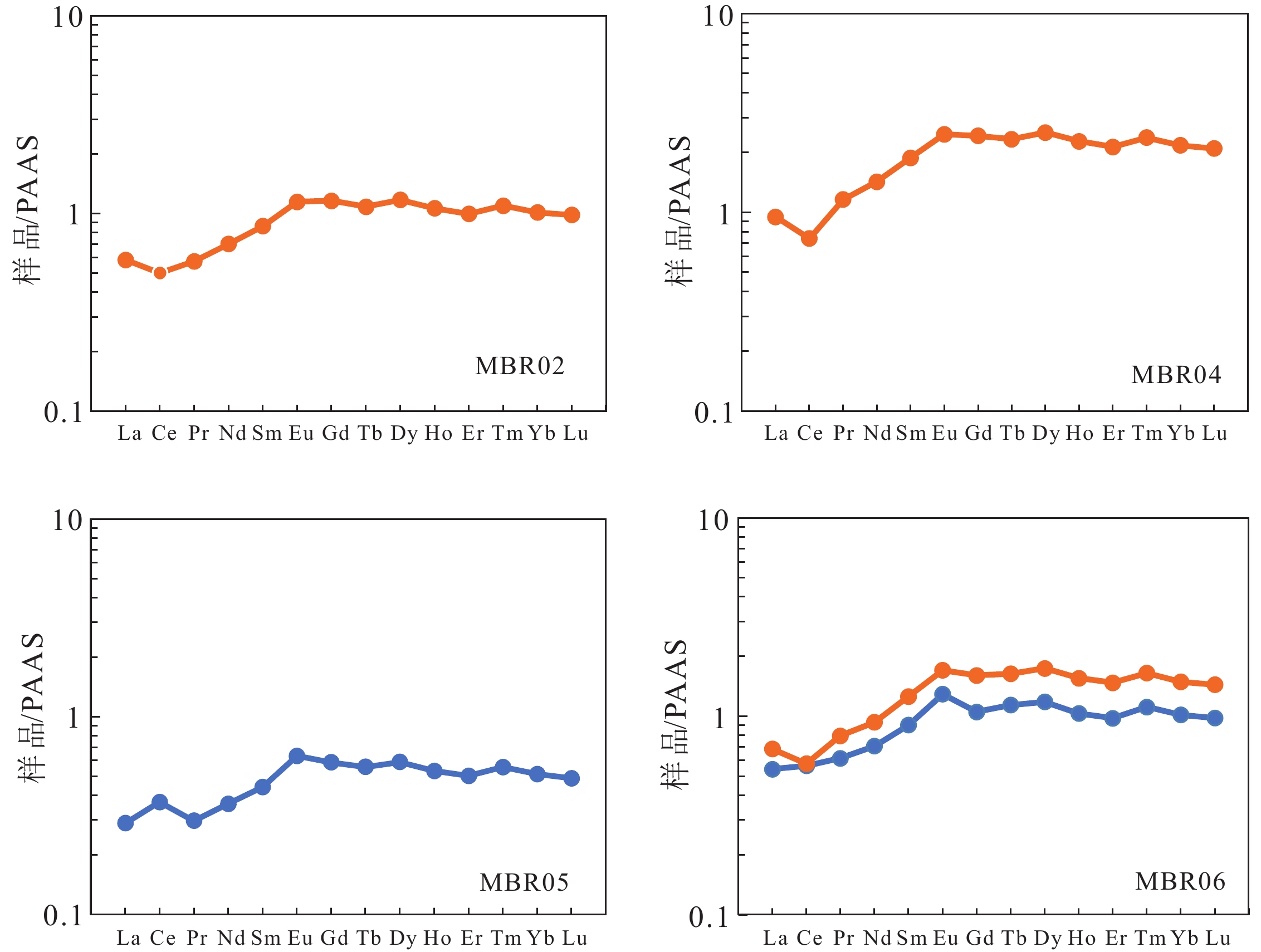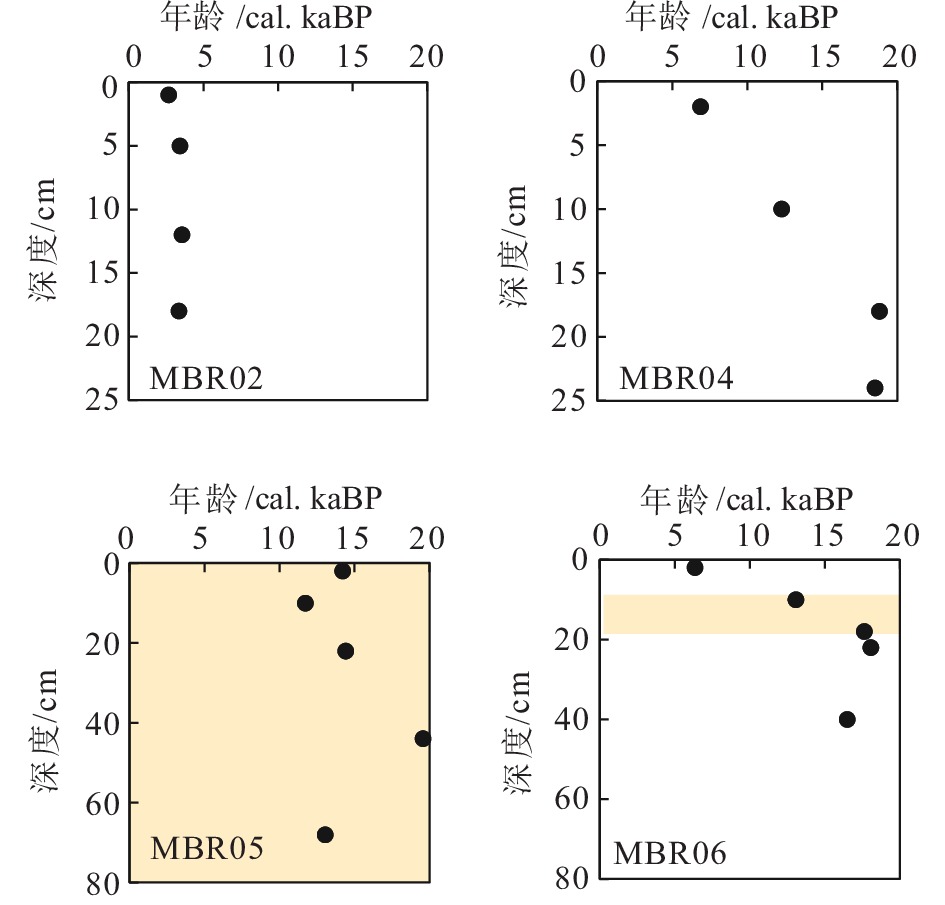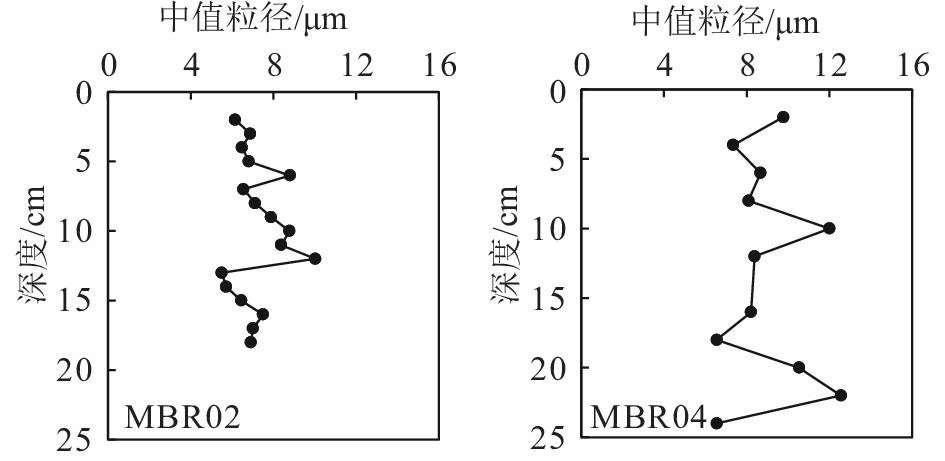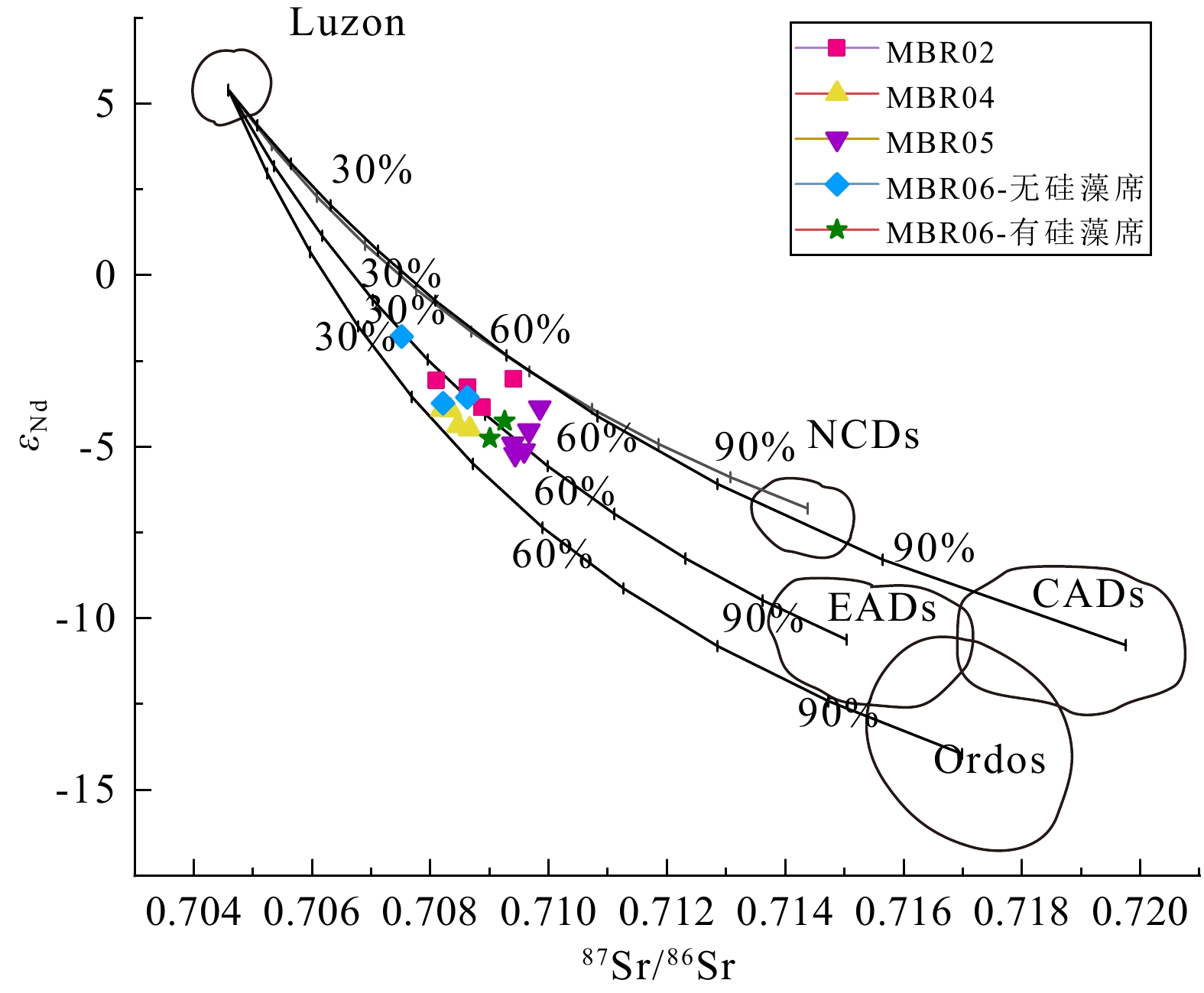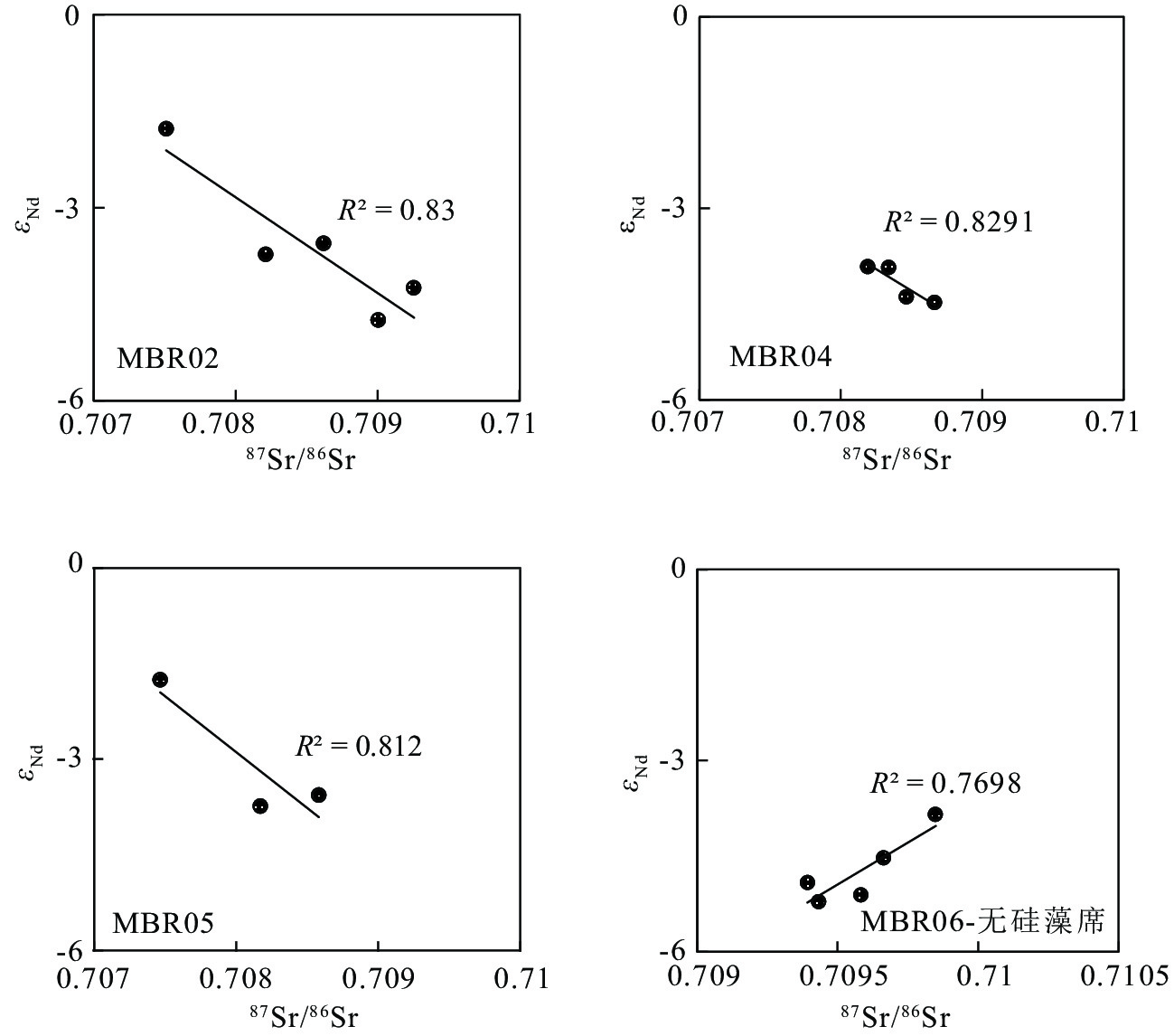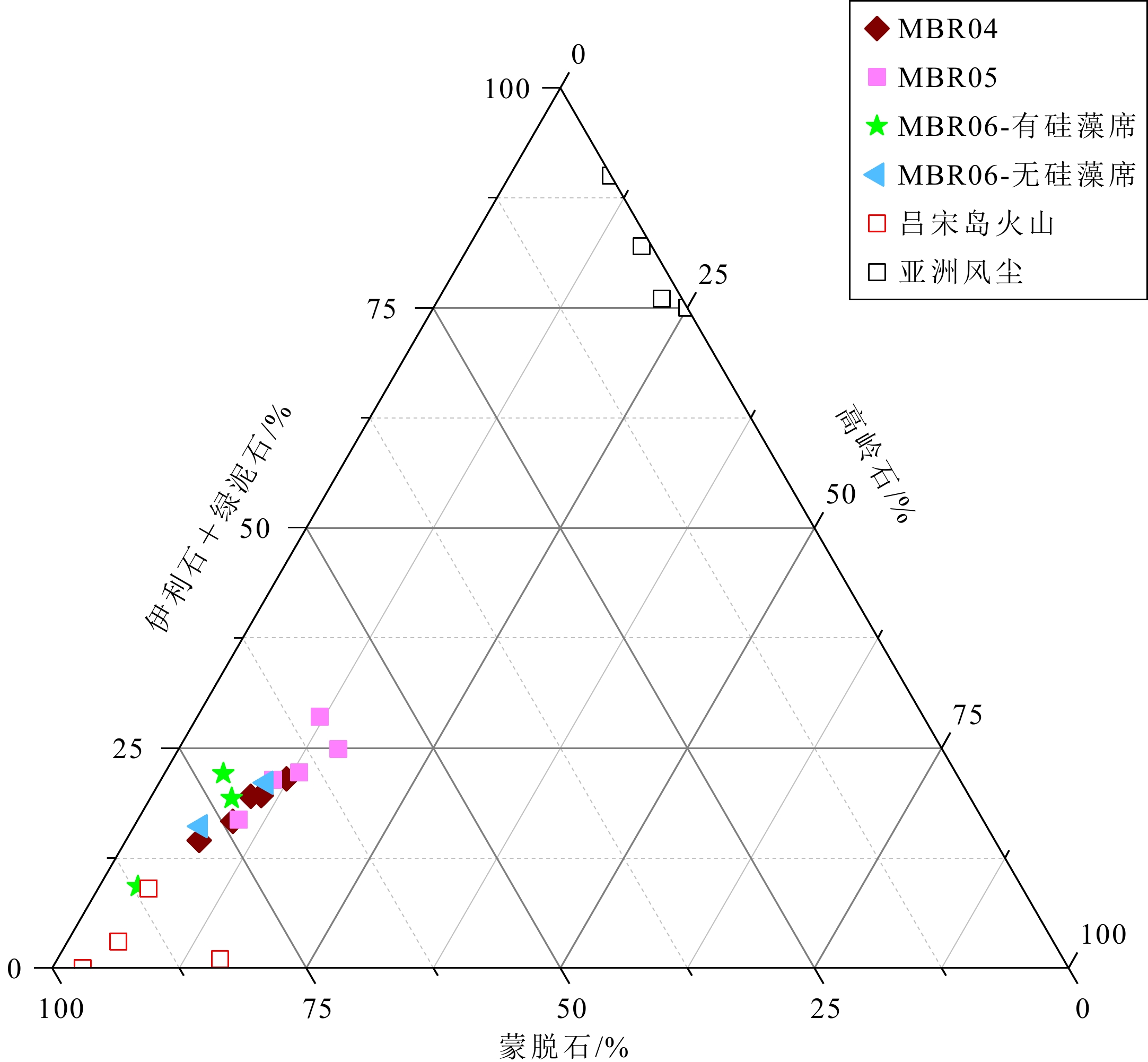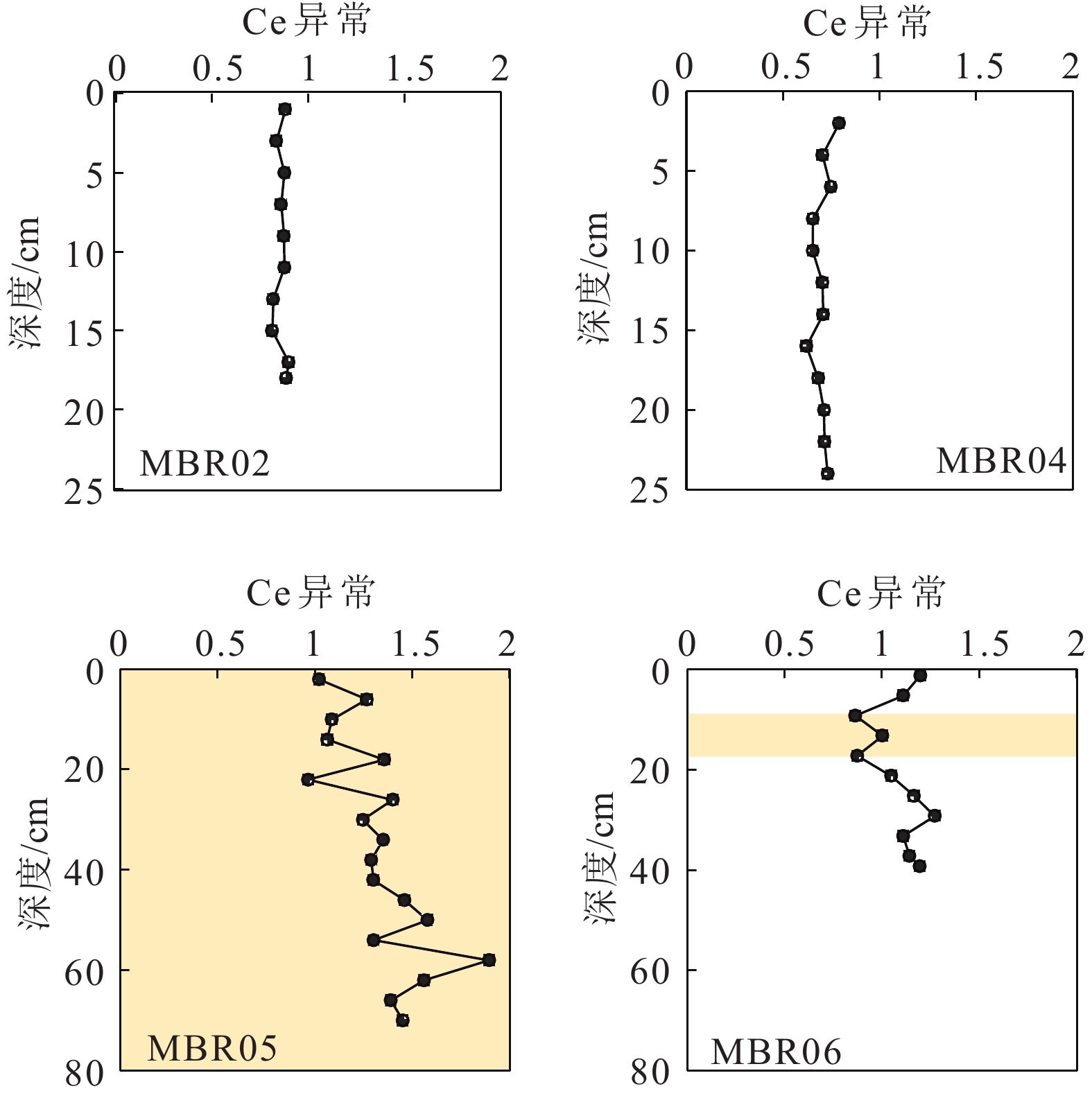Preliminary study on source and sedimentary environment in the Mariana Trench
-
摘要: 深渊海沟(水深>6000 m)作为地球表层的最深处,具有特殊的地形地貌和沉积过程,被认为是沉积物最终的汇。通过对采集于马里亚纳海沟南端水深为5800~10954 m的4个站位沉积物开展沉积地球化学研究,旨在揭示不同水深沉积物组成的差异,判别沉积物的来源和沉积环境的变化。主、微量元素含量、Sr-Nd同位素和黏土矿物组成的分析结果显示,马里亚纳海沟不同水深沉积物组成差别较大,整个MBR05和MBR06岩芯8~20 cm范围均发现大量有Ethmodiscus rex (E. rex) 组成的硅藻席沉积(laminated diatom mats, LDMs)。沉积物碎屑组分基本上是陆源风尘端元和火山物质端元的混合,且含有硅藻席沉积物的陆源风尘贡献比例更大,表明大盘筛藻大型成席硅藻的勃发可能与亚洲风尘输入有关。同时,稀土配分模式和Ce异常显示硅藻席形成于次氧化沉积环境,而不含硅藻席沉积物形成于氧化的沉积环境,可能是由于末次盛冰期风尘输入增强,刺激硅藻席勃发后快速堆积至海底,导致有机质矿化增强,进而引起沉积环境的变化。本研究对于认识深渊不同水深沉积物组成的异质性及其对底栖微生物的分布、生态和活动强度的影响有指示意义。Abstract: Hadal trenches (>6000 m) represent the deepest parts on the Earth’s surface in unique topography and sedimentary processes, and are considered the final sink of sediments. The strontium (Sr) and neodymium (Nd) isotope compositions and clay-mineral assemblages of the detrital fraction of sediments in the southern Mariana Trench, as well as the concentrations of major and trace elements of bulk sediments at water depths of 5800~10954 m were analyzed to trace the sediment provenance and distinguish the changes in the sedimentary redox conditions. The whole Core MBR05 and the interval of 8~20 cm of Core MBR06 are dominated by valve fragments of the giant diatom Ethmodiscus rex, forming laminated diatom mats (LDMs). Both Sr-Nd isotope compositions and clay-mineral assemblages of the detrital fraction reflect a two-component mixing pattern consisting of Luzon Arc volcanic clastics and Asian aeolian dusts, showing greater aeolian dust contribution on the LDMs, indicating that the bloom of E. rex may be related to Asian aeolian dust input. Meanwhile, the rare earth elements (REEs) distribution pattern and weak or absent Ce anomalies in the LDM point to suboxic conditions during the LGM formation, while the non-LDM samples exhibit vey low to zero enrichment of redox-sensitive elements and negative Ce anomalies, indicating the deposition under oxic bottom-water conditions. It is inferred that changes in sedimentary environments is associated with the enhanced mineralization of organic matter caused by the rapid deposition of E. rex giant diatom. The bloom of E. rex giant diatom may be caused by the enhanced input of wind dust during the Last Glacial Maximum. This study is of relevance for understanding the heterogeneity of sediment composition in different water depths of hadal trench and its impact on the distribution, ecology, and activity intensity of benthic microorganisms in the trench areas.
-
Keywords:
- Sr-Nd isotope /
- clay minerals /
- LDM /
- sediment sources /
- sedimentary environment /
- Mariana Trench
-
深渊区是指水深超过6000~6500 m的海域,主要由大洋海沟和海槽组成,尽管其总面积仅占全球海底面积的1%~2%,但其垂直深度构成了全球大洋深度范围的45%左右[1-5]。深渊海沟形成于板块俯冲,具有独特的非对称的“V”字型的剖面特征,有利于沉积物向海沟的轴线位置堆积和储存[6-8]。同时,这种比较局限的V字形,有助于形成高频率的海流流动,引起沉积物的再悬浮和再搬运[9]。此外,与板块交界处活跃的构造运动相关的地震、浊流等事件,导致其中的沉积物通常不太稳定,存在明显的快速沉积事件和颗粒物质的横向搬运[10],最终加速了沉积物向海沟轴部搬运。因此,深渊海沟被认为是深海沉积物重要的汇。
深渊海沟是除了洋中脊以外,地球内部与表层连通的另一个窗口,通过它可以获得地球表层与深部物质的能量交换等方面的信息[2],而其中的沉积物则是记录这些信息的绝佳载体。深海沉积物的来源通常较为复杂,主要由大陆风化剥蚀而来的陆源物质、火山碎屑以及海洋生物成因生物化石、海洋自生金属氧化物等组成[11-12]。另外,尽管深渊海沟总体作为沉积物的汇,但是同一海沟不同水深和区域的沉积物组成可能差别很大。研究发现,马里亚纳海沟、克马德克海沟和新赫布里底海沟内部的地形变化和生境特征在不同尺度上均具有明显的异质性[13]。而沉积物作为底栖生物生存的物质基础,深渊海沟内物质组成的差异控制着深渊微生物的种群分布和活动强度。Glud等[14]对克马德克和阿塔卡玛海沟海底微生物耗氧速率原位观测发现,沿着海沟轴部不同位置的微生物呼吸速率变化范围可达一个数量级以上,主要是由于局部沉积过程和物质组成差异导致的。
前人通过地球化学元素、矿物成分以及粒度组分研究发现,马里亚纳海沟南坡水深4500 m左右的沉积物主要为深海黏土,蒙脱石含量较高,同时其Eu正异常明显,而且还发现有多种基性火山碎屑矿物,说明受火山物质影响强烈[15-17]。而在更深处的深渊区发现,其深渊区的沉积物物质来源较为复杂,其物质组成主要包括陆源物质、生物碎屑物质、火山物质和自生矿物[18],说明同一海沟在不同水深和不同区域,其沉积物的来源明显不同。
另外,张金鹏等[19]在马里亚纳海沟7000 m水深处发现硅藻化石软泥沉积物,表现为二氧化硅含量极高的乳白色硅藻席沉积 (laminated diatom mat, LDM)。这种硅藻席沉积在西菲律宾海盆也有报道[20]。经过分析发现主要为大筛盘藻化石沉积(Ethmodiscus rex),数量巨大,推测在该海区曾发生过E. rex 勃发事件,且该勃发事件与末次盛冰期亚洲风尘输入增强存在很好的响应。因此,推测末次盛冰期亚洲风尘输入增强为E. rex勃发提供丰富的营养物质[21-22]。
本研究选取马里亚纳海沟南部水深5800~10954 m的海底沉积物为研究对象,旨在通过沉积地球化学研究手段,分析和对比马里亚纳海沟不同水深的沉积物组成和碎屑组分来源,探讨沉积古氧化还原条件的变化及其机制,以期对深渊沉积环境和沉积物组成的异质性有新的认识。
1. 区域背景
马里亚纳海沟形成于太平洋板块向菲律宾板块俯冲,是一条北起硫黄岛、西南至雅浦岛附近,南北向延伸向东突出,全长约2550 km的狭长弧形海沟。世界最深处“挑战者深渊”位于其中。受板块俯冲作用影响,马里亚纳海沟周边火山广泛分布,以西部吕宋岛火山及东部弧前海底火山带为主[23-24]。马里亚纳岛弧火山岩类型基本为玄武质、安山质和英安质,且年龄较新,不晚于上新世,且具有十分强烈的岛弧岩浆作用[25]。马里亚纳岛弧前弧地区存在拉斑和钙碱性系列的火山岩,其产生可能与始新世到早渐新世以及晚渐新世到古新世的两次大规模的火山活动有关[26-27]。
马里亚纳海沟区表层海水主要受到太平洋北赤道流、黑潮、棉兰老流以及赤道逆流等洋流的影响[20]。底层水主要受到两支底层流动影响:绕极底层水和北太平洋深层水[2,28]。其中,绕极底层水从南部进入太平洋并且沿着顺时针方向不断向北流动[29-30], 并途径太平洋西部的深渊区域[31]。至于北太平洋深层水在深渊中的海流向西流回阿留申群岛和千岛-堪察加半岛海沟,并向南流经日本和伊豆-小笠原海沟[2]。
2. 材料与方法
2.1 样品
研究样品于2019年11—12月由“探索一号”科考船采集于马里亚纳海沟南端(图1),水深为5800~10954 m。采样站位MBR02位于海沟轴部,由全海深着陆器底栖培养箱采集,MBR04(海盆站位)、MBR05(向海斜坡)和MBR06(向海斜坡)由大型箱式取样器采集。具体站位和岩芯信息见表1。除了MBR05整根岩芯和MBR06岩芯8~20 cm处发现有大量明显的硅藻席沉积外,其余沉积物均为黄褐色黏土组成。
表 1 沉积物柱样站位信息Table 1. Detailed information of retrieved sediment cores站位 纬度 经度 长度/cm 水深/m 位置 MBR02 11°19.62′N 142°11.28′E 18 10954 轴部 MBR04 10°45.66′N 142°16.44′E 24 5800 海盆 MBR05 10°56.52′N 141°46.08′E 70 7000 向海斜坡 MBR06 10°48.78′N 141°10.8′E 40 6530 向海斜坡 2.2 实验与方法
2.2.1 主微量和稀土元素
沉积物样品冷冻干燥后研磨均匀至粒度小于200目。沉积物SiO2含量用碱溶方法处理,除SiO2外的沉积物主、微量和稀土元素用酸溶方法处理。微量、稀土元素的测试采用电感耦合等离子体质谱仪,常量元素测试采用电感耦合等离子体发射光谱仪,测试前对空白样、重复样和若干标准样进行测试以控制样品的测试精度和准确度。样品测试在中国科学院贵阳地球化学研究所完成。常量元素含量的相对标准偏差<3%,微量、稀土元素含量的相对标准偏差<10%。
2.2.2 Sr-Nd同位素
称取适量冻干沉积物研磨后的沉积物首先分别去除钙质、有机质、铁锰自生矿物及生物硅[32-33]。将前处理后的残渣放入特氟龙杯中,先后加入HNO3、HCl、HF并加热至180 ℃,12小时后在电热板上蒸酸至近干。接着加入0.5 mL的HCl,同样电热板上蒸干,再添加5 mL的 6% HCl,密封加热至120 ℃,5小时后取出,再加入0.3 mL的10%抗坏血酸后过离子交换柱分离Sr和Nd,转移到离心管之后上机测试。测试过程中,采用86Sr/88Sr=0.1194内部校正仪器质量分馏,Sr同位素国际标准物质NISTSRM987作为外标校正仪器漂移;采用146Nd/144Nd=0.7219内部校正仪器质量分馏,Nd同位素国际标准物质JNdi-1作为外标校正仪器漂移。前处理与测定在南京聚谱检测科技有限公司完成。
2.2.3 总有机碳放射性14C年龄测定
称取一定量的粉末状样品, 用10%的HCl进行酸溶去除无机碳。然后用去离子水清洗至中性后冷冻干燥,称取38~40 mg样品用于上机测试。在处理过程中同时进行空白和标样的酸处理, 以矫正酸处理过程对有机质14C 年龄结果的影响。前处理与测定在中国科学院广州地球化学研究所完成。利用Calib.8.2程序中Marine 20校正曲线和全球平均储库年龄(400 a)将放射性14C年龄转换成校正后日历年龄。
2.2.4 黏土矿物
称取约1.5 g未研磨的干燥沉积物样品,前处理去除钙质和有机质。清洗至中性倒入300 mL的烧杯,加水充分搅匀。根据斯托克定律在20℃室温下静置4小时5分钟使其中黏土矿物(<2 μm)与粉砂(2~63 μm)分离。使用虹吸管虹吸液面下5 cm浑浊液体,离心浑浊液以提取沉积物。之后将离心后的沉积物,制成自然片、乙二醇片、高温片分别上机测试。基于Biscaye的方法,根据不同矿物在X光扫描后峰值位置不同(蒙脱石,17 Å;伊利石,10 Å;高岭石/绿泥石,7 Å)对矿物含量进行半定量分析[34]。之后根据3.57/3.54 Å峰区数值对高岭石和绿泥石含量进行定量。前处理与测定在东京海洋大学完成。
2.2.5 粒度测试
取适量样品前处理分别去除有机质、碳酸盐、铁、锰自生矿物及和生物硅。之后使用贝克曼激光粒度仪(Beckmann Coulter LS13320)对处理后的样品进行测试。测试范围为0.02~2000 m,重复测试误差<3%。
3. 结果
3.1 主微量和稀土元素
5个站位的常量元素百分比含量见附表1,微量元素含量数据见附表2,稀土元素含量数据见附表3。Al和Ti由于其稳定的化学性质,常被作为参照值对常量元素进行标准化,以降低生源物质稀释效应并更好地反映元素指示的岩性变化[35]。各站位铁、锰以及主要氧化还原敏感元素(Zn、U、V、Co、Ni)及二氧化硅百分含量与Al比值随深度变化如图2所示,相对上地壳平均富集系数如图3所示,富集系数=[(X/Al样品)/(X/Al上地壳)] [36]。硅藻席沉积基本由生物蛋白石组成,故二氧化硅含量与硅藻席沉积含量有较好对应关系,可以近似用样品二氧化硅含量变化来指示硅藻席含量变化,二氧化硅含量越高,硅藻席沉积密度越大。硅藻席沉积样品中铁锰元素与Al比值相对无硅藻席沉积样品呈降低趋势。图3中选定的元素均相对上地壳含量呈不同程度富集,硅藻席沉积中氧化还原敏感元素相对无硅藻席沉积略微富集,而铁锰则相对亏损。澳大利亚太古宙页岩(PAAS)标准化后的稀土配分如图4所示。硅藻席沉积样品稀土元素比值显著低于无硅藻席沉积样品,总体低于PAAS含量(比值<1),而含硅藻席沉积样品稀土元素含量明显高于无硅藻席沉积样品,变化范围也相对更大。无硅藻席沉积样品统一表现出轻稀土(La—Nd)相对亏损特征,在中稀土(Sm—Tb)与重稀土(Dy—Lu)相对富集的特征。轴部站位MBR02中、重稀土接近PAAS值,而其他站位均表现相对于PAAS明显富集。特别注意到,Ce元素在无硅藻席沉积中均表现为负异常,而在硅藻席沉积中呈明显正异常。
1 各站位主量元素值1. Concentrations of major elements of each site% 样品名 Al Na Mg P K Ca Ti Mn Fe SiO2 MBR02-1 6.08 1.38 5.41 0.10 1.37 1.51 0.39 0.45 5.86 51.40 MBR02-3 5.58 1.29 5.12 0.09 1.28 1.38 0.35 0.41 5.48 53.45 MBR02-5 6.06 1.34 5.75 0.09 1.36 1.66 0.40 0.45 6.17 50.27 MBR02-7 5.54 1.28 4.96 0.08 1.24 1.40 0.33 0.39 5.34 54.62 MBR02-9 5.87 1.41 5.22 0.09 1.33 1.45 0.37 0.44 5.63 52.49 MBR02-11 6.23 1.35 5.63 0.10 1.40 1.57 0.40 0.47 6.26 49.95 MBR02-13 5.77 1.38 5.50 0.09 1.25 1.73 0.37 0.45 5.69 52.32 MBR02-15 4.91 1.36 4.37 0.08 1.17 1.24 0.30 2.24 4.76 54.74 MBR02-17 5.33 1.30 4.82 0.09 1.27 1.35 0.34 0.46 5.39 55.04 MBR02-18 5.72 1.47 5.07 0.09 1.31 1.45 0.36 0.43 5.51 52.83 MBR04-2 6.76 1.69 2.71 0.15 1.54 2.06 0.43 2.12 7.39 46.72 MBR04-4 7.34 1.64 2.90 0.16 1.67 2.10 0.46 0.89 7.03 49.04 MBR04-6 7.40 1.58 2.86 0.15 1.73 2.05 0.46 0.89 7.02 49.71 MBR04-8 7.37 1.52 2.86 0.16 1.71 2.12 0.46 0.94 7.09 49.29 MBR04-10 7.12 1.52 2.81 0.16 1.71 2.10 0.47 0.99 7.15 49.93 MBR04-12 7.69 1.54 2.82 0.15 1.70 2.09 0.48 0.94 7.05 48.95 MBR04-14 7.47 1.57 2.88 0.16 1.70 2.01 0.47 0.89 7.10 48.91 MBR04-16 7.50 1.53 2.73 0.15 1.65 2.09 0.48 0.85 7.07 49.48 MBR04-18 8.19 1.56 2.89 0.14 1.77 2.07 0.49 0.81 7.29 47.20 MBR04-20 8.07 1.48 2.85 0.14 1.79 2.03 0.49 0.76 7.25 47.99 MBR04-22 7.91 1.47 2.76 0.14 1.76 1.92 0.48 0.77 7.23 48.35 MBR04-24 7.90 1.62 2.67 0.14 1.76 1.83 0.48 0.74 7.11 48.00 MBR05-2 5.09 2.38 2.28 0.06 1.28 1.12 0.31 0.27 4.30 57.35 MBR05-6 2.31 1.59 1.14 0.03 0.62 0.53 0.14 0.50 1.95 73.31 MBR05-10 2.48 1.61 1.25 0.03 0.65 0.59 0.15 0.34 2.22 71.48 MBR05-14 5.37 2.10 2.52 0.07 1.35 1.28 0.34 0.15 4.73 57.47 MBR05-18 2.72 2.29 1.41 0.04 0.75 0.78 0.19 0.47 2.52 66.18 MBR05-22 3.61 2.33 1.98 0.06 0.99 1.12 0.26 0.28 3.64 61.65 MBR05-26 2.70 2.16 1.34 0.03 0.73 0.63 0.16 0.38 2.32 68.93 MBR05-30 4.03 1.93 1.78 0.05 1.07 0.83 0.24 0.06 3.40 64.95 MBR05-34 2.51 1.13 1.10 0.03 0.67 0.49 0.15 0.14 1.92 75.15 MBR05-38 2.88 0.92 1.26 0.04 0.74 0.61 0.17 0.08 2.48 73.75 MBR05-42 1.38 0.63 0.63 0.02 0.37 0.31 0.08 0.03 1.13 81.36 MBR05-46 3.58 1.20 1.61 0.04 0.97 0.75 0.23 0.11 3.19 69.52 MBR05-50 1.76 1.89 0.94 0.02 0.55 0.41 0.12 0.03 1.49 75.50 MBR05-54 3.36 2.10 1.50 0.04 0.98 0.73 0.22 0.07 3.05 61.49 MBR05-58 1.23 1.06 0.60 0.02 0.36 0.32 0.07 0.46 1.14 80.00 MBR05-62 1.45 0.93 0.71 0.02 0.41 0.35 0.09 0.17 1.63 79.27 MBR05-66 2.05 1.04 0.96 0.02 0.55 0.47 0.12 0.06 1.90 76.59 MBR05-70 1.25 1.05 0.64 0.02 0.36 0.31 0.08 0.09 1.05 80.60 MBR06-2 4.57 2.33 3.33 0.07 1.05 1.95 0.39 0.42 5.48 51.69 MBR06-6 4.76 2.10 3.38 0.08 1.13 1.64 0.36 0.41 5.29 56.47 MBR06-10 3.42 1.81 1.85 0.04 0.88 0.87 0.22 0.15 2.96 68.03 MBR06-14 5.39 2.09 3.14 0.08 1.37 1.48 0.38 0.17 5.42 55.11 MBR06-18 5.18 1.72 2.53 0.07 1.34 1.30 0.34 0.10 4.53 59.91 MBR06-22 5.83 2.23 2.94 0.09 1.51 1.82 0.41 0.11 6.12 47.19 MBR06-26 6.01 2.02 3.13 0.10 1.68 2.01 0.45 1.36 7.01 49.80 MBR06-30 6.02 1.70 3.06 0.11 1.70 2.04 0.48 1.19 7.66 47.70 MBR06-34 6.40 1.88 3.28 0.14 1.62 2.23 0.51 0.76 7.11 47.81 MBR06-38 6.37 1.72 2.93 0.13 1.65 2.17 0.50 0.69 7.29 48.93 MBR06-40 5.82 1.65 2.46 0.13 1.71 2.07 0.48 1.94 6.96 50.78 2 各站位微量元素值2. Concentrations of trace elements of each siteμg/g 样品名 Co Ni Cu Zn V U Pb Cr Ba MBR02-1 60.34 197.47 188.94 113.57 132.90 1.06 22.96 169.93 182.15 MBR02-3 52.61 181.38 178.27 106.29 131.96 1.02 21.65 154.20 175.06 MBR02-5 54.52 213.83 184.51 119.34 147.59 1.19 23.82 194.55 195.61 MBR02-7 47.42 183.44 164.05 100.43 120.33 1.04 19.59 146.43 167.79 MBR02-9 52.76 213.14 179.71 107.79 136.85 1.20 22.37 149.73 188.44 MBR02-11 56.40 206.55 196.06 115.67 144.17 1.28 24.03 171.16 198.59 MBR02-13 49.99 209.19 170.37 102.34 135.09 1.14 18.50 200.05 168.92 MBR02-15 49.45 192.52 167.88 99.37 132.69 1.12 18.61 200.46 172.02 MBR02-17 46.39 247.44 176.49 95.74 127.90 1.25 18.79 126.25 172.39 MBR02-18 45.96 167.94 162.65 100.31 124.58 1.17 20.31 135.82 177.71 MBR04-2 133.99 272.11 426.86 186.71 177.14 0.73 44.49 103.27 518.43 MBR04-4 52.42 150.42 226.42 138.05 155.57 1.37 30.39 79.22 569.12 MBR04-6 49.23 147.65 224.00 141.81 163.02 1.45 31.46 81.42 563.61 MBR04-8 53.69 150.66 230.78 139.68 165.73 1.43 32.04 77.69 553.97 MBR04-10 49.21 162.54 244.73 141.72 180.01 1.51 32.42 77.62 591.61 MBR04-12 54.55 163.23 235.26 137.41 174.88 1.50 32.59 78.34 582.07 MBR04-14 68.24 154.14 229.26 137.33 173.01 1.54 34.05 86.62 662.49 MBR04-16 47.42 152.70 242.72 134.49 171.48 1.49 32.50 76.65 569.47 MBR04-18 54.17 147.32 239.31 141.31 170.88 1.69 33.04 78.83 713.94 MBR04-20 55.89 133.61 225.54 140.04 174.89 1.64 32.67 79.89 707.11 MBR04-22 49.15 146.92 233.38 150.86 178.26 1.82 36.12 78.83 743.24 MBR04-24 55.30 135.05 220.51 143.08 176.44 1.80 35.72 73.18 760.55 MBR05-2 34.26 77.42 144.94 91.11 96.92 1.03 18.37 67.33 822.05 MBR05-6 32.52 68.48 119.10 48.86 59.74 0.48 11.44 35.99 442.73 MBR05-10 29.65 54.92 106.52 52.23 59.87 0.60 8.84 37.73 490.13 MBR05-14 26.46 67.16 132.44 98.81 99.43 1.13 15.79 75.30 823.96 MBR05-18 51.26 56.59 108.94 56.49 80.52 0.74 15.50 39.42 522.35 MBR05-22 50.15 60.14 123.98 75.10 93.08 0.16 19.19 61.15 565.68 MBR05-26 48.86 54.18 104.69 49.16 69.88 0.74 15.29 38.91 547.38 MBR05-30 16.42 46.45 105.41 72.45 77.34 0.95 11.46 54.15 641.84 MBR05-34 22.10 35.75 78.69 45.95 57.86 0.69 9.70 33.58 483.07 MBR05-38 23.23 39.84 99.75 54.54 64.42 0.76 13.77 38.86 506.45 MBR05-42 8.36 22.59 49.76 27.15 32.20 0.45 5.47 21.49 376.82 MBR05-46 33.84 53.06 121.43 66.67 75.35 0.98 21.19 51.39 488.84 MBR05-50 10.73 31.70 60.56 36.19 47.71 0.25 6.39 35.99 389.47 MBR05-54 15.54 47.52 105.82 67.71 82.29 0.91 15.56 50.18 516.73 MBR05-58 65.57 67.49 111.51 26.93 42.96 0.52 11.63 18.30 328.57 MBR05-62 36.85 34.15 93.61 40.44 39.92 0.49 16.31 20.39 315.99 MBR05-66 16.42 37.94 78.92 43.26 54.16 0.60 12.25 26.70 426.74 MBR05-70 9.95 39.72 67.95 29.48 40.60 0.39 7.10 20.90 334.82 MBR06-2 46.90 132.32 175.67 96.73 135.93 0.50 18.55 81.02 420.03 MBR06-6 48.32 122.41 181.07 98.97 121.75 0.88 15.34 57.82 502.60 MBR06-10 37.65 54.71 107.11 65.51 89.41 0.66 26.93 92.73 677.58 MBR06-14 36.51 96.91 174.51 113.07 126.97 0.25 20.99 67.05 603.16 MBR06-18 50.42 62.77 151.17 96.24 106.20 0.98 24.29 70.97 569.37 MBR06-22 35.05 73.01 161.81 117.25 135.44 1.05 25.67 82.60 486.62 MBR06-26 77.24 207.22 260.88 153.08 163.40 1.20 28.89 78.62 435.12 MBR06-30 54.02 228.85 289.79 138.13 173.10 1.12 29.17 85.36 377.45 MBR06-34 55.74 174.65 227.66 132.76 177.01 1.28 30.11 77.76 387.46 MBR06-38 57.67 171.86 224.86 139.13 171.07 0.32 33.50 84.75 486.05 MBR06-40 57.06 297.23 436.16 156.10 179.55 1.38 24.46 80.22 477.80 3 各站位稀土元素值3. Concentrations of REEs of each siteμg/g 样品名 La Ce Pr Nd Sm Eu Gd Tb Dy Ho Er Tm Yb Lu MBR02-1 22.98 42.39 5.29 22.76 5.15 1.31 5.94 0.86 5.27 1.09 3.11 0.46 3.01 0.44 MBR02-3 22.30 39.43 5.25 21.10 4.86 1.21 5.39 0.78 5.11 1.05 2.91 0.45 2.83 0.43 MBR02-5 23.93 44.28 5.60 22.96 5.22 1.38 5.93 0.88 5.62 1.16 3.20 0.48 3.12 0.47 MBR02-7 20.94 37.53 4.78 21.45 4.69 1.27 5.19 0.82 4.92 1.03 2.69 0.41 2.66 0.39 MBR02-9 23.11 42.12 5.28 22.90 4.95 1.29 5.61 0.84 5.23 1.08 2.96 0.44 2.89 0.43 MBR02-11 23.93 44.29 5.60 24.41 5.11 1.35 5.83 0.89 5.54 1.15 3.05 0.47 3.03 0.45 MBR02-13 22.61 37.93 4.98 23.48 4.88 1.28 5.47 0.87 5.47 1.11 2.91 0.45 2.85 0.43 MBR02-15 21.34 36.72 5.02 22.83 4.81 1.26 5.45 0.87 5.23 1.08 2.93 0.44 2.81 0.43 MBR02-17 19.57 36.89 4.52 20.56 4.25 1.11 4.66 0.75 4.48 0.93 2.51 0.39 2.47 0.37 MBR02-18 20.82 38.46 4.75 22.00 4.45 1.14 5.10 0.78 4.76 0.97 2.65 0.40 2.66 0.40 MBR04-2 35.48 64.65 9.90 44.28 10.09 2.57 10.94 1.78 10.27 2.12 5.80 0.90 5.71 0.83 MBR04-4 35.57 57.18 9.77 43.84 10.06 2.63 10.88 1.76 10.57 2.18 6.02 0.94 5.86 0.85 MBR04-6 33.64 58.55 9.57 42.73 10.02 2.62 11.05 1.71 10.67 2.19 6.00 0.91 5.78 0.85 MBR04-8 35.06 54.35 10.29 44.41 10.41 2.71 10.93 1.76 11.10 2.27 6.15 0.94 6.21 0.90 MBR04-10 36.23 56.16 10.64 45.31 10.91 2.72 11.64 1.78 11.14 2.29 6.25 0.96 6.15 0.94 MBR04-12 36.07 58.51 10.07 44.93 10.67 2.69 11.57 1.79 11.05 2.28 6.15 0.95 6.03 0.90 MBR04-14 34.02 57.74 10.22 44.55 10.36 2.60 11.43 1.79 10.91 2.27 6.10 0.93 6.11 0.92 MBR04-16 35.69 51.51 10.11 45.14 10.70 2.78 11.74 1.83 11.16 2.31 6.13 0.95 6.28 0.92 MBR04-18 39.28 61.77 10.98 48.02 10.87 2.86 11.72 1.84 11.38 2.37 6.33 0.98 6.18 0.92 MBR04-20 37.48 61.96 10.60 44.96 10.50 2.71 11.32 1.80 10.87 2.26 6.20 0.94 6.02 0.90 MBR04-22 38.71 64.55 11.04 50.74 11.27 2.85 11.89 1.91 12.34 2.40 6.75 1.02 6.39 0.96 MBR04-24 37.00 62.63 10.41 47.74 10.29 2.77 11.53 1.82 11.31 2.32 6.23 0.96 6.21 0.91 MBR05-2 20.15 44.04 4.89 20.80 4.40 1.32 4.88 0.78 4.54 0.95 2.57 0.40 2.48 0.37 MBR05-6 9.95 26.57 2.34 10.38 2.06 0.58 2.28 0.35 2.11 0.49 1.20 0.18 1.17 0.17 MBR05-10 11.02 25.19 2.58 11.75 2.38 0.68 2.78 0.41 2.51 0.53 1.38 0.22 1.39 0.20 MBR05-14 19.51 45.10 4.89 21.12 4.49 1.31 5.16 0.81 4.84 1.01 2.77 0.43 2.80 0.40 MBR05-18 11.44 32.99 2.74 11.80 2.59 0.75 2.84 0.43 2.69 0.53 1.48 0.23 1.46 0.22 MBR05-22 18.47 37.59 4.36 19.56 4.16 1.19 4.83 0.74 4.44 0.94 2.54 0.38 2.37 0.33 MBR05-26 11.90 34.65 2.73 12.50 2.55 0.73 2.83 0.42 2.57 0.51 1.42 0.21 1.37 0.20 MBR05-30 16.47 43.02 3.83 17.87 3.67 1.02 4.12 0.62 3.81 0.78 2.12 0.32 2.13 0.32 MBR05-34 8.72 24.02 1.92 8.02 1.80 0.53 2.08 0.33 1.99 0.41 1.14 0.18 1.14 0.17 MBR05-38 10.56 28.33 2.42 10.52 2.24 0.65 2.61 0.41 2.55 0.52 1.44 0.23 1.47 0.21 MBR05-42 5.46 15.10 1.31 5.53 1.16 0.32 1.29 0.20 1.19 0.24 0.65 0.10 0.66 0.10 MBR05-46 11.35 35.98 2.83 12.04 2.66 0.79 2.84 0.47 2.97 0.60 1.69 0.27 1.73 0.26 MBR05-50 6.10 20.88 1.52 6.50 1.50 0.37 1.72 0.26 1.60 0.32 0.89 0.14 0.88 0.13 MBR05-54 11.00 32.81 3.04 13.26 2.94 0.84 3.29 0.53 3.32 0.65 1.85 0.28 1.81 0.27 MBR05-58 6.56 25.78 1.49 6.66 1.36 0.34 1.47 0.22 1.28 0.25 0.69 0.10 0.64 0.10 MBR05-62 7.37 24.10 1.71 7.28 1.52 0.38 1.61 0.25 1.48 0.29 0.81 0.12 0.78 0.11 MBR05-66 7.40 22.85 1.93 8.41 1.84 0.49 1.96 0.31 1.81 0.36 1.00 0.15 0.99 0.14 MBR05-70 4.70 14.89 1.18 4.98 1.13 0.26 1.21 0.18 1.09 0.21 0.59 0.09 0.57 0.08 MBR06-2 15.83 40.29 4.30 19.41 4.45 1.18 5.18 0.80 5.06 1.01 2.80 0.43 2.74 0.40 MBR06-6 19.26 38.59 4.77 22.19 4.71 1.29 5.31 0.86 5.31 1.06 2.91 0.44 2.84 0.43 MBR06-10 13.51 36.08 3.40 14.91 3.30 0.87 3.32 0.55 3.31 0.67 1.82 0.28 1.74 0.26 MBR06-14 21.64 43.69 5.79 23.47 5.44 1.57 5.50 0.97 5.78 1.15 3.15 0.47 2.92 0.41 MBR06-18 20.59 45.08 5.48 22.64 5.06 1.42 4.95 0.88 5.20 1.04 2.84 0.45 2.85 0.42 MBR06-22 27.41 49.89 7.11 30.14 6.92 1.94 7.23 1.21 7.05 1.46 4.01 0.62 3.90 0.59 MBR06-26 28.63 51.56 7.45 31.22 7.35 1.93 7.79 1.29 7.80 1.60 4.32 0.67 4.34 0.64 MBR06-30 28.43 47.15 7.64 31.66 7.42 1.93 7.89 1.32 8.12 1.67 4.57 0.71 4.52 0.67 MBR06-34 30.76 46.48 8.39 33.60 8.38 2.21 8.87 1.52 9.48 1.89 5.15 0.82 5.22 0.75 MBR06-38 29.37 43.11 8.36 33.88 8.33 2.13 8.51 1.53 9.13 1.83 5.04 0.77 4.73 0.71 MBR06-40 28.83 52.43 8.88 37.17 8.93 2.42 9.72 1.56 9.51 1.95 5.46 0.83 5.17 0.78 3.2 总有机碳放射性14C年龄
总有机碳放射性14C年龄和校正后的日历年龄如表2所示,日历年龄随深度变化如图5所示。各个站位年龄数据不随深度单调递增,部分样品发生年龄倒转。轴部站位MBR02沉积物TOC的14C年龄相对其他站位更加年轻,为约2.7~3.5 cal.kaBP。MBR04、MBR05、MBR06站位14C年龄分别为约6.9~18.8、11.7~19.6、6.3~8 cal.kaBP。
表 2 马里亚纳海沟总有机碳放射性14C定年结果Table 2. Total organic carbon AMS-14C dating results of the Mariana Trench sediments样品编号 深度
/cm放射性14C年龄
/aBP校正后日历年龄
/cal.aBPMBR02-1 1 3 040±25 2 664±25 MBR02-5 5 3 675±30 3 421±30 MBR02-12 12 3 780±30 3 544±30 MBR02-18 18 3 615±30 3 352±30 MBR04-2 2 6 600±40 6 886±40 MBR04-10 10 10 960±60 12 285±60 MBR04-18 18 16 290±180 18 798±180 MBR04-24 24 16 040±130 18 517±130 MBR05-2 2 12 690±120 14 206±120 MBR05-10 10 10 590±90 11 703±90 MBR05-22 22 12 810±70 14 394±70 MBR05-44 44 16 950±130 19 559±130 MBR05-68 68 11 720±80 13 037±80 MBR06-2 2 6 095±40 6 327±40 MBR06-10 10 11 730±150 13 049±150 MBR06-18 18 15 240±150 17 630±150 MBR06-22 22 15 610±160 18 063±160 MBR06-40 40 14 300±140 16 473±140 3.3 Sr-Nd同位素
Sr-Nd同位素数据见附表4。放射性143Nd/144Nd表示为εNd(0)=(143Nd/144Nd–0.512638)×104 [37]。样品有无硅藻席沉积的Sr-Nd同位素组成差别较大。无硅藻席沉积放射性锶钕同位素值较为一致,平均值(87Sr/86Sr≈0.7085,εNd(0)≈−3.5)与现代大洋深海沉积平均值(87Sr/86Sr≈0.70917,εNd(0)≈−4~0)相近,而与附近的马里亚纳岛数值差别较大(87Sr/86Sr≈0.7032~0.7035,εNd(0)≈7.0615~9.0122[38])。受硅藻席沉积影响,放射性锶钕同位素值与西太平洋深海沉积平均值差别较大,表现为更高的更具有放射性的87Sr/86Sr值和更低的εNd(0),平均值分别为0.7094和4.5。
4 各站位Sr-Nd同位素及含量4. Sr-Nd isotope and the concentrations in each site样品名 87Sr/86Sr 143Nd//144Nd Sr含量/(μg/g) Nd含量/(μg/g) MBR02-2 0.7094 0.5125 135.07 21.10 MBR02-7 0.7086 0.5125 124.48 21.45 MBR02-12 0.7081 0.5125 139.06 23.48 MBR02-18 0.7089 0.5124 125.95 22.00 MBR04-4 0.7082 0.5124 205.77 43.84 MBR04-10 0.7083 0.5124 211.84 45.31 MBR04-18 0.7085 0.5124 222 48.02 MBR04-24 0.7087 0.5124 225.25 47.74 MBR05-2 0.7094 0.5124 132.55 20.8 MBR05-10 0.7098 0.5124 74.75 11.75 MBR05-24 0.7097 0.5124 113.28 19.56 MBR05-44 0.7094 0.5124 86.18 12.04 MBR05-68 0.7096 0.5124 38.67 4.98 MBR06-2 0.7075 0.5125 128.71 19.41 MBR06-10 0.7090 0.5124 88.07 14.91 MBR06-18 0.7093 0.5124 125.72 22.64 MBR06-26 0.7082 0.5124 182.9 31.22 MBR06-40 0.7086 0.5125 208.78 37.17 3.4 黏土矿物
黏土矿物数据见附表5。研究区黏土矿物组成基本以蒙脱石为主(约70%~80%),伊利石次之(约15%~25%),高岭石最少(约1%~4%)。站位间黏土矿物含量差异不大,硅藻席沉积相对无硅藻席沉积样品具有更高的伊利石含量与更低的蒙脱石含量。含硅藻席沉积的MBR05站位具有最低的蒙脱石含量(平均71.7%)和最高的伊利石含量(平均25.2%),与之同为向海斜坡的MBR06站位不含硅藻席沉积的部分含有最高的蒙脱石含量(平均80.6%)和最低的伊利石含量(平均17.7%)。海盆站位MBR04黏土矿物含量介于二者之间,蒙脱石平均为77.4%,伊利石平均为19.9%。
5 各站位黏土矿物含量5. Clay mineral composition and relevant parameters in each site样品名 蒙脱石/% 伊利石/% 高岭石/% 绿泥石/% MBR05-6 64.5 13.1 4.5 17.8 MBR05-14 73.9 12.1 2.7 11.2 MBR05-26 71.9 14.7 3.4 10.0 MBR05-46 68.5 18.1 2.9 10.5 MBR05-70 79.5 10.8 2.1 7.5 MBR06-2 88.7 3.9 1.9 5.5 MBR06-10 74.5 11.5 2.5 11.5 MBR06-18 82.0 6.9 0.9 10.1 MBR06-26 77.9 8.6 1.4 12.1 MBR06-40 75.3 6.1 1.6 17.0 3.5 粒度
沉积物样品碎屑组分的平均粒径、中值粒径及黏土、粉砂、砂占比如附表6所示,中值粒径随深度变化如图6所示。硅藻席样品受内部大量生物蛋白石影响,难以完全提取碎屑组分进行粒度测试,故只报道MBR02和MBR04数据。粒度总体上随沉积深度变化不大,MBR02站位平均粒径为10.7 μm,平均中值粒径为7.2 μm;MBR04站位平均粒径为21.4 μm,平均中值粒径9 μm。两站位在组成上均以粉砂为主,黏土次之。
6 各站位沉积物平均粒度及组成6. Average grain size of sediments and relative fractions at each site编号 平均粒径/μm 中值粒径/μm 黏土含量/% 粉砂含量/% 砂含量/% MBR02-2 9.28 6.15 34.89 65.11 0.00 MBR02-3 10.9 6.87 32.42 65.75 1.82 MBR02-4 9.36 6.48 34.41 65.59 0.00 MBR02-5 9.82 6.81 31.21 68.79 0.00 MBR02-6 12.5 8.8 24.17 75.22 0.00 MBR02-7 11.72 6.55 33.47 63.88 0.00 MBR02-8 10.77 7.11 30.81 69.14 0.00 MBR02-9 10.32 7.89 27.87 72.13 0.00 MBR02-10 11.78 8.78 24.94 71.26 0.00 MBR02-11 11.83 8.37 26.55 73.44 0.00 MBR02-12 14.61 10.02 22.6 76.82 0.55 MBR02-13 9.25 5.50 40.04 59.84 0.12 MBR02-14 8.62 5.71 37.85 62.15 0.00 MBR02-15 9.04 6.44 32.76 67.24 0.00 MBR02-16 10.54 7.5 27.71 72.29 0.00 MBR02-17 10.76 7.01 31.02 68.92 0.06 MBR02-18 10.28 6.9 31.42 67.86 0.02 MBR04-2 36.01 9.77 24.92 65.94 9.14 MBR04-4 17.34 7.35 30.55 63.00 6.45 MBR04-6 19.73 8.67 26.81 65.04 8.15 MBR04-8 21.13 8.09 31.16 60.47 8.37 MBR04-10 28.73 12.00 21.15 66.41 12.44 MBR04-12 20.09 8.38 29.02 63.70 7.28 MBR04-16 17.79 8.21 26.36 66.75 6.89 MBR04-18 14.10 6.55 31.72 62.83 5.46 MBR04-20 21.07 10.53 22.02 71.19 6.79 MBR04-22 21.95 12.56 18.82 74.00 7.18 MBR04-24 12.68 6.55 33.46 63.67 2.86 4. 讨论
4.1 碎屑组分物源示踪
Sr-Nd同位素示踪的主要原理是不同母岩地质体中的Sr-Nd同位素比值差异较大,这种差异与其矿物成分、年龄有关,尤其Nd同位素不受化学风化、生物过程和蒸发作用的影响,是可靠的示踪指标[39]。根据前人研究推断,研究区马里亚纳海沟南部沉积物主要为以吕宋岛火山物质为代表的年轻火山链输入和以东亚沙漠(EADs)、中央亚洲沙漠(CADs)、北亚沙漠(NCDs)为主导的亚洲风尘输入[40-42]。在Sr-εNd(0)相关图(图7)上可以看出,研究站位Sr-Nd同位素组合主要落在吕宋岛弧和亚洲风尘混合线之间,火山物质来源和风尘源约各占一半。总体来看,轴部站位(MBR02)的Sr-Nd同位素特征显示,火山物质的来源贡献比例最高,这可能是受到俯冲板块上盘海底火山风化剥蚀进而被搬运至海沟轴部的影响。此外,样品有无硅藻席沉积在图上表现出一定源区差异:无硅藻席沉积样品中以火山质相对贡献略高,平均占50%~60%,而含有硅藻席沉积样品以风尘物质的相对贡献偏高,平均占50%~60%。因此,含有硅藻席沉积的样品受风尘输入的影响更大。已有研究表明,粒度对碎屑组分Sr同位素比值有较大影响,这主要是由于不同粒径的矿物组成及其同位素组成差异导致的[43]。据Feng等的研究推测,碎屑颗粒粒径大小对Nd-Sr同位素判别物源的影响可达20%[40,43]。本研究各柱样的粒度对深度变化不大(图6),中值粒径为6~13 μm,因此,认为粒度变化对Sr-Nd判别物源的结果影响不大。
![]() 图 7 马里亚纳海沟沉积物与可能物源源区87Sr/86Sr-εNd图画圈区为各个可能源区,其中吕宋火山源区(Luzon)与风尘源区间曲线为二者混合曲线。NCDs:北亚洲沙漠,CADs:中央亚洲沙漠,EADs:东亚洲沙漠,Ordos:鄂尔多斯沙漠。亚洲风尘数据源:吕宋岛风尘数据来自Dfant等 [44];亚洲风尘数据来自Honda等[45], Woodhead [46-47], Chen [48], Rao [49], Nakano [50], Seo [51]。Figure 7. 87Sr/86Sr vs εNd ratio of detrital sediments in the Mariana Trench and possible source areas
图 7 马里亚纳海沟沉积物与可能物源源区87Sr/86Sr-εNd图画圈区为各个可能源区,其中吕宋火山源区(Luzon)与风尘源区间曲线为二者混合曲线。NCDs:北亚洲沙漠,CADs:中央亚洲沙漠,EADs:东亚洲沙漠,Ordos:鄂尔多斯沙漠。亚洲风尘数据源:吕宋岛风尘数据来自Dfant等 [44];亚洲风尘数据来自Honda等[45], Woodhead [46-47], Chen [48], Rao [49], Nakano [50], Seo [51]。Figure 7. 87Sr/86Sr vs εNd ratio of detrital sediments in the Mariana Trench and possible source areas一般来说,火山物质和陆源物质两个源区端元混合使得沉积物碎屑组分的Sr-Nd同位素呈负相关关系[52]。但在硅藻席沉积的样品中,Sr-Nd同位素呈明显正相关(图8)。研究发现,东亚风尘源区的Sr-Nd同位素呈现弱的正相关 [45]。由于硅藻席沉积受风尘输入影响明显,推测Sr-Nd同位素正相关关系可能也是由于继承了风尘端元Sr-Nd同位素信息导致的。同时,硅藻席样品Sr-Nd同位素数据基本落在火山物质端元和东亚风尘端元的混合线上。事实上,对西菲律宾海硅藻席E. rex壳体的硅同位素研究显示,硅藻席的勃发受到明显陆源风尘硅来源的影响[53]。但是受分析样品数量的限制,基于线性相关分析得出的结论可能不具普遍性,需更多的后续研究证实该推测。
黏土矿物大多是由母岩经风化作用而形成,粒径通常小于2 μm,可被远距离搬运,是深海沉积物的重要组成部分。源区、气候等因素均会影响到黏土矿物的组成。海洋环境的变化,控制和影响着海洋沉积物中的黏土矿物组成,因此,海洋沉积物中黏土矿物组合特征可以作为研究海洋环境演变的指标[54-60]。研究区黏土矿物组成表现出蒙脱石主导的特征。蒙脱石的主要来源之一是火山物质蚀变的产物,同时,黏土矿物组分三角图显示,大部分样品与吕宋岛黏土矿物组成相近,指示了黏土矿物物源以火山物质为主。其中,硅藻席沉积与无硅藻席沉积样品均位于火山物质端元和亚洲风尘端元的混合线上,但是,硅藻席沉积的黏土矿物组合略微更接近风尘端元(图9),这与Sr-Nd同位素分析结果吻合。
4.2 末次盛冰期沉积环境变化
在稀土元素配分中,硅藻席沉积样品可以明显观测到Ce元素相较PAAS正异常,而无硅藻席沉积样品中则为负异常。在氧化海洋沉积环境中,Ce由正三价被氧化至正四价,四价Ce表现出易吸附于悬浮胶体或铁锰氧化物的特点,因此,在沉积物中表现为相对亏损,呈负异常。在亚氧化-还原性环境中,Ce由正四价被还原至正三价,其特性与其他三价稀土元素相似,导致最小分馏,在该情况下表现为无异常或弱正异常[63-66]。
稀土元素的Ce异常(δCe=CeN/[(LaN +PrN )/2][34],其中N表示样品与球粒陨石数值比值),δCe>1为正异常,δCe<1为负异常。Ce异常值随深度变化如图10所示。无硅藻席沉积站位Ce异常值接近典型热带远洋土沉积物[22],呈现弱Ce负异常,指示氧化性沉积环境。而轴部站位(MBR02)Ce异常值平均为0.865,略微高于其他无硅藻席沉积站位平均值(0.736)。含硅藻席沉积样品显著区别于无硅藻席沉积样品,Ce呈明显弱正异常,且该异常值变化趋势与SiO2含量变化有较好的正相关性(图11)。因此,硅藻席沉积含量越多,Ce正异常越明显,指示越强的次氧化-还原性环境。至于硅藻席古沉积环境到底是次氧化环境还是缺氧-还原性环境,Luo等[36]通过对沉积物中Mo-U含量相关关系的研究也发现硅藻席沉积指示次氧化的沉积环境。
Xiong与Luo等通过对不同组分沉积物氧化还原敏感元素对比,发现硅藻席沉积相对无硅藻席沉积表现出主要氧化还原敏感元素的富集,并推测指示硅藻席沉积为相对次氧化环境[22,36]。然而本研究主要氧化还原敏感元素富集系数相对上地壳富集,但并未表现出硅藻席沉积相对于无硅藻席沉积物样品更为富集的特征(图3)。结合元素随深度变化特征发现(图2),大部分氧化还原敏感元素与铁锰元素变化趋势一致。推测沉积物影响氧化还原敏感元素的主要为铁锰氧化物。铁锰元素含量在硅藻席沉积中相对无硅藻席呈现降低趋势,铁锰氧化物一般在次氧化-还原的沉积环境中被有机质还原而发生分解,这也与Ce推测的硅藻席沉积指示的偏还原的环境一致。另外,轴部站位相对其他无硅藻席站位表现出相对高Ce异常值与低铁锰富集系数(图2),推测指示轴部站位相对更还原的氧化还原环境,可能是由于轴部较强的微生物活动而引起较快氧气消耗导致的[8]。如图2与图5所示,MBR05站位中SiO2含量在约40 cm深度达最大值,对应年龄约为19 cal.kaBP,MBR06站位硅藻席深度年龄约为18 cal.kaBP,均与末次冰盛期时间对应,指示大部分硅藻席沉积形成于末次盛冰期,这与前人在菲律宾海盆和马里亚纳海沟南坡发现的硅藻席定年结果一致[36,53]。值得注意的是,部分沉积年龄出现倒置现象,使得MBR05柱样尽管都存在硅藻席沉积,但定年结果并不都落在末次盛冰期期间,这可能与海沟区不稳定的沉积特征有关[9,67]。结合Sr-Nd同位素和黏土矿物的物源分析结果推测,E. rex大型成席硅藻勃发后死去的硅藻遗体沉积至海底,提供了大量的有机物质,使海底的微生物活动增强,耗氧增加,进而引起氧化还原条件由氧化变为次氧化。而E. rex勃发可能是由于末次盛冰期盛行西风的显著增强,使得亚洲风尘向西太平洋的输入增加,带来了更多微量营养元素,为E. rex勃发提供了良好的条件。
5. 总结
通过对马里亚纳海沟沉积物主微量和稀土元素、Sr-Nd同位素、黏土矿物组成、总有机碳放射性14C年龄的分析,发现不同水深沉积物组成差别显著,沉积物中碎屑组分来源基本是陆源风尘和火山碎屑物质,含E. rex硅藻席样品中的陆源风尘贡献略高于不含硅藻席沉积样品。同时,含硅藻席样品中显示次氧化的沉积环境,而不含硅藻席沉积样品则为氧化环境。这一变化机制推测出E. rex在末次盛冰期大量勃发后沉降到海底,使得有机质矿化增强,微生物耗氧增加,引起沉积环境发生变化。
致谢:沉积物样品由上海海洋大学深渊中心采得,感谢全体采样人员与船员。感谢东京海洋大学山中寿郎教授对实验的帮助。
-
图 7 马里亚纳海沟沉积物与可能物源源区87Sr/86Sr-εNd图
画圈区为各个可能源区,其中吕宋火山源区(Luzon)与风尘源区间曲线为二者混合曲线。NCDs:北亚洲沙漠,CADs:中央亚洲沙漠,EADs:东亚洲沙漠,Ordos:鄂尔多斯沙漠。亚洲风尘数据源:吕宋岛风尘数据来自Dfant等 [44];亚洲风尘数据来自Honda等[45], Woodhead [46-47], Chen [48], Rao [49], Nakano [50], Seo [51]。
Figure 7. 87Sr/86Sr vs εNd ratio of detrital sediments in the Mariana Trench and possible source areas
The circled areas are possible sources. The curves were drawn from between Luzon volcanic endmember and Asian dust endmembers in two-component mixing model. Data source: Luzon: Dfant et al., 1990[44]; Asian dust: Honda et al.[45], Woodhead [46-47], Chen [48], Rao [49], Nakano [50], Seo [51].
表 1 沉积物柱样站位信息
Table 1 Detailed information of retrieved sediment cores
站位 纬度 经度 长度/cm 水深/m 位置 MBR02 11°19.62′N 142°11.28′E 18 10954 轴部 MBR04 10°45.66′N 142°16.44′E 24 5800 海盆 MBR05 10°56.52′N 141°46.08′E 70 7000 向海斜坡 MBR06 10°48.78′N 141°10.8′E 40 6530 向海斜坡 1 各站位主量元素值
1 Concentrations of major elements of each site
% 样品名 Al Na Mg P K Ca Ti Mn Fe SiO2 MBR02-1 6.08 1.38 5.41 0.10 1.37 1.51 0.39 0.45 5.86 51.40 MBR02-3 5.58 1.29 5.12 0.09 1.28 1.38 0.35 0.41 5.48 53.45 MBR02-5 6.06 1.34 5.75 0.09 1.36 1.66 0.40 0.45 6.17 50.27 MBR02-7 5.54 1.28 4.96 0.08 1.24 1.40 0.33 0.39 5.34 54.62 MBR02-9 5.87 1.41 5.22 0.09 1.33 1.45 0.37 0.44 5.63 52.49 MBR02-11 6.23 1.35 5.63 0.10 1.40 1.57 0.40 0.47 6.26 49.95 MBR02-13 5.77 1.38 5.50 0.09 1.25 1.73 0.37 0.45 5.69 52.32 MBR02-15 4.91 1.36 4.37 0.08 1.17 1.24 0.30 2.24 4.76 54.74 MBR02-17 5.33 1.30 4.82 0.09 1.27 1.35 0.34 0.46 5.39 55.04 MBR02-18 5.72 1.47 5.07 0.09 1.31 1.45 0.36 0.43 5.51 52.83 MBR04-2 6.76 1.69 2.71 0.15 1.54 2.06 0.43 2.12 7.39 46.72 MBR04-4 7.34 1.64 2.90 0.16 1.67 2.10 0.46 0.89 7.03 49.04 MBR04-6 7.40 1.58 2.86 0.15 1.73 2.05 0.46 0.89 7.02 49.71 MBR04-8 7.37 1.52 2.86 0.16 1.71 2.12 0.46 0.94 7.09 49.29 MBR04-10 7.12 1.52 2.81 0.16 1.71 2.10 0.47 0.99 7.15 49.93 MBR04-12 7.69 1.54 2.82 0.15 1.70 2.09 0.48 0.94 7.05 48.95 MBR04-14 7.47 1.57 2.88 0.16 1.70 2.01 0.47 0.89 7.10 48.91 MBR04-16 7.50 1.53 2.73 0.15 1.65 2.09 0.48 0.85 7.07 49.48 MBR04-18 8.19 1.56 2.89 0.14 1.77 2.07 0.49 0.81 7.29 47.20 MBR04-20 8.07 1.48 2.85 0.14 1.79 2.03 0.49 0.76 7.25 47.99 MBR04-22 7.91 1.47 2.76 0.14 1.76 1.92 0.48 0.77 7.23 48.35 MBR04-24 7.90 1.62 2.67 0.14 1.76 1.83 0.48 0.74 7.11 48.00 MBR05-2 5.09 2.38 2.28 0.06 1.28 1.12 0.31 0.27 4.30 57.35 MBR05-6 2.31 1.59 1.14 0.03 0.62 0.53 0.14 0.50 1.95 73.31 MBR05-10 2.48 1.61 1.25 0.03 0.65 0.59 0.15 0.34 2.22 71.48 MBR05-14 5.37 2.10 2.52 0.07 1.35 1.28 0.34 0.15 4.73 57.47 MBR05-18 2.72 2.29 1.41 0.04 0.75 0.78 0.19 0.47 2.52 66.18 MBR05-22 3.61 2.33 1.98 0.06 0.99 1.12 0.26 0.28 3.64 61.65 MBR05-26 2.70 2.16 1.34 0.03 0.73 0.63 0.16 0.38 2.32 68.93 MBR05-30 4.03 1.93 1.78 0.05 1.07 0.83 0.24 0.06 3.40 64.95 MBR05-34 2.51 1.13 1.10 0.03 0.67 0.49 0.15 0.14 1.92 75.15 MBR05-38 2.88 0.92 1.26 0.04 0.74 0.61 0.17 0.08 2.48 73.75 MBR05-42 1.38 0.63 0.63 0.02 0.37 0.31 0.08 0.03 1.13 81.36 MBR05-46 3.58 1.20 1.61 0.04 0.97 0.75 0.23 0.11 3.19 69.52 MBR05-50 1.76 1.89 0.94 0.02 0.55 0.41 0.12 0.03 1.49 75.50 MBR05-54 3.36 2.10 1.50 0.04 0.98 0.73 0.22 0.07 3.05 61.49 MBR05-58 1.23 1.06 0.60 0.02 0.36 0.32 0.07 0.46 1.14 80.00 MBR05-62 1.45 0.93 0.71 0.02 0.41 0.35 0.09 0.17 1.63 79.27 MBR05-66 2.05 1.04 0.96 0.02 0.55 0.47 0.12 0.06 1.90 76.59 MBR05-70 1.25 1.05 0.64 0.02 0.36 0.31 0.08 0.09 1.05 80.60 MBR06-2 4.57 2.33 3.33 0.07 1.05 1.95 0.39 0.42 5.48 51.69 MBR06-6 4.76 2.10 3.38 0.08 1.13 1.64 0.36 0.41 5.29 56.47 MBR06-10 3.42 1.81 1.85 0.04 0.88 0.87 0.22 0.15 2.96 68.03 MBR06-14 5.39 2.09 3.14 0.08 1.37 1.48 0.38 0.17 5.42 55.11 MBR06-18 5.18 1.72 2.53 0.07 1.34 1.30 0.34 0.10 4.53 59.91 MBR06-22 5.83 2.23 2.94 0.09 1.51 1.82 0.41 0.11 6.12 47.19 MBR06-26 6.01 2.02 3.13 0.10 1.68 2.01 0.45 1.36 7.01 49.80 MBR06-30 6.02 1.70 3.06 0.11 1.70 2.04 0.48 1.19 7.66 47.70 MBR06-34 6.40 1.88 3.28 0.14 1.62 2.23 0.51 0.76 7.11 47.81 MBR06-38 6.37 1.72 2.93 0.13 1.65 2.17 0.50 0.69 7.29 48.93 MBR06-40 5.82 1.65 2.46 0.13 1.71 2.07 0.48 1.94 6.96 50.78 2 各站位微量元素值
2 Concentrations of trace elements of each site
μg/g 样品名 Co Ni Cu Zn V U Pb Cr Ba MBR02-1 60.34 197.47 188.94 113.57 132.90 1.06 22.96 169.93 182.15 MBR02-3 52.61 181.38 178.27 106.29 131.96 1.02 21.65 154.20 175.06 MBR02-5 54.52 213.83 184.51 119.34 147.59 1.19 23.82 194.55 195.61 MBR02-7 47.42 183.44 164.05 100.43 120.33 1.04 19.59 146.43 167.79 MBR02-9 52.76 213.14 179.71 107.79 136.85 1.20 22.37 149.73 188.44 MBR02-11 56.40 206.55 196.06 115.67 144.17 1.28 24.03 171.16 198.59 MBR02-13 49.99 209.19 170.37 102.34 135.09 1.14 18.50 200.05 168.92 MBR02-15 49.45 192.52 167.88 99.37 132.69 1.12 18.61 200.46 172.02 MBR02-17 46.39 247.44 176.49 95.74 127.90 1.25 18.79 126.25 172.39 MBR02-18 45.96 167.94 162.65 100.31 124.58 1.17 20.31 135.82 177.71 MBR04-2 133.99 272.11 426.86 186.71 177.14 0.73 44.49 103.27 518.43 MBR04-4 52.42 150.42 226.42 138.05 155.57 1.37 30.39 79.22 569.12 MBR04-6 49.23 147.65 224.00 141.81 163.02 1.45 31.46 81.42 563.61 MBR04-8 53.69 150.66 230.78 139.68 165.73 1.43 32.04 77.69 553.97 MBR04-10 49.21 162.54 244.73 141.72 180.01 1.51 32.42 77.62 591.61 MBR04-12 54.55 163.23 235.26 137.41 174.88 1.50 32.59 78.34 582.07 MBR04-14 68.24 154.14 229.26 137.33 173.01 1.54 34.05 86.62 662.49 MBR04-16 47.42 152.70 242.72 134.49 171.48 1.49 32.50 76.65 569.47 MBR04-18 54.17 147.32 239.31 141.31 170.88 1.69 33.04 78.83 713.94 MBR04-20 55.89 133.61 225.54 140.04 174.89 1.64 32.67 79.89 707.11 MBR04-22 49.15 146.92 233.38 150.86 178.26 1.82 36.12 78.83 743.24 MBR04-24 55.30 135.05 220.51 143.08 176.44 1.80 35.72 73.18 760.55 MBR05-2 34.26 77.42 144.94 91.11 96.92 1.03 18.37 67.33 822.05 MBR05-6 32.52 68.48 119.10 48.86 59.74 0.48 11.44 35.99 442.73 MBR05-10 29.65 54.92 106.52 52.23 59.87 0.60 8.84 37.73 490.13 MBR05-14 26.46 67.16 132.44 98.81 99.43 1.13 15.79 75.30 823.96 MBR05-18 51.26 56.59 108.94 56.49 80.52 0.74 15.50 39.42 522.35 MBR05-22 50.15 60.14 123.98 75.10 93.08 0.16 19.19 61.15 565.68 MBR05-26 48.86 54.18 104.69 49.16 69.88 0.74 15.29 38.91 547.38 MBR05-30 16.42 46.45 105.41 72.45 77.34 0.95 11.46 54.15 641.84 MBR05-34 22.10 35.75 78.69 45.95 57.86 0.69 9.70 33.58 483.07 MBR05-38 23.23 39.84 99.75 54.54 64.42 0.76 13.77 38.86 506.45 MBR05-42 8.36 22.59 49.76 27.15 32.20 0.45 5.47 21.49 376.82 MBR05-46 33.84 53.06 121.43 66.67 75.35 0.98 21.19 51.39 488.84 MBR05-50 10.73 31.70 60.56 36.19 47.71 0.25 6.39 35.99 389.47 MBR05-54 15.54 47.52 105.82 67.71 82.29 0.91 15.56 50.18 516.73 MBR05-58 65.57 67.49 111.51 26.93 42.96 0.52 11.63 18.30 328.57 MBR05-62 36.85 34.15 93.61 40.44 39.92 0.49 16.31 20.39 315.99 MBR05-66 16.42 37.94 78.92 43.26 54.16 0.60 12.25 26.70 426.74 MBR05-70 9.95 39.72 67.95 29.48 40.60 0.39 7.10 20.90 334.82 MBR06-2 46.90 132.32 175.67 96.73 135.93 0.50 18.55 81.02 420.03 MBR06-6 48.32 122.41 181.07 98.97 121.75 0.88 15.34 57.82 502.60 MBR06-10 37.65 54.71 107.11 65.51 89.41 0.66 26.93 92.73 677.58 MBR06-14 36.51 96.91 174.51 113.07 126.97 0.25 20.99 67.05 603.16 MBR06-18 50.42 62.77 151.17 96.24 106.20 0.98 24.29 70.97 569.37 MBR06-22 35.05 73.01 161.81 117.25 135.44 1.05 25.67 82.60 486.62 MBR06-26 77.24 207.22 260.88 153.08 163.40 1.20 28.89 78.62 435.12 MBR06-30 54.02 228.85 289.79 138.13 173.10 1.12 29.17 85.36 377.45 MBR06-34 55.74 174.65 227.66 132.76 177.01 1.28 30.11 77.76 387.46 MBR06-38 57.67 171.86 224.86 139.13 171.07 0.32 33.50 84.75 486.05 MBR06-40 57.06 297.23 436.16 156.10 179.55 1.38 24.46 80.22 477.80 3 各站位稀土元素值
3 Concentrations of REEs of each site
μg/g 样品名 La Ce Pr Nd Sm Eu Gd Tb Dy Ho Er Tm Yb Lu MBR02-1 22.98 42.39 5.29 22.76 5.15 1.31 5.94 0.86 5.27 1.09 3.11 0.46 3.01 0.44 MBR02-3 22.30 39.43 5.25 21.10 4.86 1.21 5.39 0.78 5.11 1.05 2.91 0.45 2.83 0.43 MBR02-5 23.93 44.28 5.60 22.96 5.22 1.38 5.93 0.88 5.62 1.16 3.20 0.48 3.12 0.47 MBR02-7 20.94 37.53 4.78 21.45 4.69 1.27 5.19 0.82 4.92 1.03 2.69 0.41 2.66 0.39 MBR02-9 23.11 42.12 5.28 22.90 4.95 1.29 5.61 0.84 5.23 1.08 2.96 0.44 2.89 0.43 MBR02-11 23.93 44.29 5.60 24.41 5.11 1.35 5.83 0.89 5.54 1.15 3.05 0.47 3.03 0.45 MBR02-13 22.61 37.93 4.98 23.48 4.88 1.28 5.47 0.87 5.47 1.11 2.91 0.45 2.85 0.43 MBR02-15 21.34 36.72 5.02 22.83 4.81 1.26 5.45 0.87 5.23 1.08 2.93 0.44 2.81 0.43 MBR02-17 19.57 36.89 4.52 20.56 4.25 1.11 4.66 0.75 4.48 0.93 2.51 0.39 2.47 0.37 MBR02-18 20.82 38.46 4.75 22.00 4.45 1.14 5.10 0.78 4.76 0.97 2.65 0.40 2.66 0.40 MBR04-2 35.48 64.65 9.90 44.28 10.09 2.57 10.94 1.78 10.27 2.12 5.80 0.90 5.71 0.83 MBR04-4 35.57 57.18 9.77 43.84 10.06 2.63 10.88 1.76 10.57 2.18 6.02 0.94 5.86 0.85 MBR04-6 33.64 58.55 9.57 42.73 10.02 2.62 11.05 1.71 10.67 2.19 6.00 0.91 5.78 0.85 MBR04-8 35.06 54.35 10.29 44.41 10.41 2.71 10.93 1.76 11.10 2.27 6.15 0.94 6.21 0.90 MBR04-10 36.23 56.16 10.64 45.31 10.91 2.72 11.64 1.78 11.14 2.29 6.25 0.96 6.15 0.94 MBR04-12 36.07 58.51 10.07 44.93 10.67 2.69 11.57 1.79 11.05 2.28 6.15 0.95 6.03 0.90 MBR04-14 34.02 57.74 10.22 44.55 10.36 2.60 11.43 1.79 10.91 2.27 6.10 0.93 6.11 0.92 MBR04-16 35.69 51.51 10.11 45.14 10.70 2.78 11.74 1.83 11.16 2.31 6.13 0.95 6.28 0.92 MBR04-18 39.28 61.77 10.98 48.02 10.87 2.86 11.72 1.84 11.38 2.37 6.33 0.98 6.18 0.92 MBR04-20 37.48 61.96 10.60 44.96 10.50 2.71 11.32 1.80 10.87 2.26 6.20 0.94 6.02 0.90 MBR04-22 38.71 64.55 11.04 50.74 11.27 2.85 11.89 1.91 12.34 2.40 6.75 1.02 6.39 0.96 MBR04-24 37.00 62.63 10.41 47.74 10.29 2.77 11.53 1.82 11.31 2.32 6.23 0.96 6.21 0.91 MBR05-2 20.15 44.04 4.89 20.80 4.40 1.32 4.88 0.78 4.54 0.95 2.57 0.40 2.48 0.37 MBR05-6 9.95 26.57 2.34 10.38 2.06 0.58 2.28 0.35 2.11 0.49 1.20 0.18 1.17 0.17 MBR05-10 11.02 25.19 2.58 11.75 2.38 0.68 2.78 0.41 2.51 0.53 1.38 0.22 1.39 0.20 MBR05-14 19.51 45.10 4.89 21.12 4.49 1.31 5.16 0.81 4.84 1.01 2.77 0.43 2.80 0.40 MBR05-18 11.44 32.99 2.74 11.80 2.59 0.75 2.84 0.43 2.69 0.53 1.48 0.23 1.46 0.22 MBR05-22 18.47 37.59 4.36 19.56 4.16 1.19 4.83 0.74 4.44 0.94 2.54 0.38 2.37 0.33 MBR05-26 11.90 34.65 2.73 12.50 2.55 0.73 2.83 0.42 2.57 0.51 1.42 0.21 1.37 0.20 MBR05-30 16.47 43.02 3.83 17.87 3.67 1.02 4.12 0.62 3.81 0.78 2.12 0.32 2.13 0.32 MBR05-34 8.72 24.02 1.92 8.02 1.80 0.53 2.08 0.33 1.99 0.41 1.14 0.18 1.14 0.17 MBR05-38 10.56 28.33 2.42 10.52 2.24 0.65 2.61 0.41 2.55 0.52 1.44 0.23 1.47 0.21 MBR05-42 5.46 15.10 1.31 5.53 1.16 0.32 1.29 0.20 1.19 0.24 0.65 0.10 0.66 0.10 MBR05-46 11.35 35.98 2.83 12.04 2.66 0.79 2.84 0.47 2.97 0.60 1.69 0.27 1.73 0.26 MBR05-50 6.10 20.88 1.52 6.50 1.50 0.37 1.72 0.26 1.60 0.32 0.89 0.14 0.88 0.13 MBR05-54 11.00 32.81 3.04 13.26 2.94 0.84 3.29 0.53 3.32 0.65 1.85 0.28 1.81 0.27 MBR05-58 6.56 25.78 1.49 6.66 1.36 0.34 1.47 0.22 1.28 0.25 0.69 0.10 0.64 0.10 MBR05-62 7.37 24.10 1.71 7.28 1.52 0.38 1.61 0.25 1.48 0.29 0.81 0.12 0.78 0.11 MBR05-66 7.40 22.85 1.93 8.41 1.84 0.49 1.96 0.31 1.81 0.36 1.00 0.15 0.99 0.14 MBR05-70 4.70 14.89 1.18 4.98 1.13 0.26 1.21 0.18 1.09 0.21 0.59 0.09 0.57 0.08 MBR06-2 15.83 40.29 4.30 19.41 4.45 1.18 5.18 0.80 5.06 1.01 2.80 0.43 2.74 0.40 MBR06-6 19.26 38.59 4.77 22.19 4.71 1.29 5.31 0.86 5.31 1.06 2.91 0.44 2.84 0.43 MBR06-10 13.51 36.08 3.40 14.91 3.30 0.87 3.32 0.55 3.31 0.67 1.82 0.28 1.74 0.26 MBR06-14 21.64 43.69 5.79 23.47 5.44 1.57 5.50 0.97 5.78 1.15 3.15 0.47 2.92 0.41 MBR06-18 20.59 45.08 5.48 22.64 5.06 1.42 4.95 0.88 5.20 1.04 2.84 0.45 2.85 0.42 MBR06-22 27.41 49.89 7.11 30.14 6.92 1.94 7.23 1.21 7.05 1.46 4.01 0.62 3.90 0.59 MBR06-26 28.63 51.56 7.45 31.22 7.35 1.93 7.79 1.29 7.80 1.60 4.32 0.67 4.34 0.64 MBR06-30 28.43 47.15 7.64 31.66 7.42 1.93 7.89 1.32 8.12 1.67 4.57 0.71 4.52 0.67 MBR06-34 30.76 46.48 8.39 33.60 8.38 2.21 8.87 1.52 9.48 1.89 5.15 0.82 5.22 0.75 MBR06-38 29.37 43.11 8.36 33.88 8.33 2.13 8.51 1.53 9.13 1.83 5.04 0.77 4.73 0.71 MBR06-40 28.83 52.43 8.88 37.17 8.93 2.42 9.72 1.56 9.51 1.95 5.46 0.83 5.17 0.78 表 2 马里亚纳海沟总有机碳放射性14C定年结果
Table 2 Total organic carbon AMS-14C dating results of the Mariana Trench sediments
样品编号 深度
/cm放射性14C年龄
/aBP校正后日历年龄
/cal.aBPMBR02-1 1 3 040±25 2 664±25 MBR02-5 5 3 675±30 3 421±30 MBR02-12 12 3 780±30 3 544±30 MBR02-18 18 3 615±30 3 352±30 MBR04-2 2 6 600±40 6 886±40 MBR04-10 10 10 960±60 12 285±60 MBR04-18 18 16 290±180 18 798±180 MBR04-24 24 16 040±130 18 517±130 MBR05-2 2 12 690±120 14 206±120 MBR05-10 10 10 590±90 11 703±90 MBR05-22 22 12 810±70 14 394±70 MBR05-44 44 16 950±130 19 559±130 MBR05-68 68 11 720±80 13 037±80 MBR06-2 2 6 095±40 6 327±40 MBR06-10 10 11 730±150 13 049±150 MBR06-18 18 15 240±150 17 630±150 MBR06-22 22 15 610±160 18 063±160 MBR06-40 40 14 300±140 16 473±140 4 各站位Sr-Nd同位素及含量
4 Sr-Nd isotope and the concentrations in each site
样品名 87Sr/86Sr 143Nd//144Nd Sr含量/(μg/g) Nd含量/(μg/g) MBR02-2 0.7094 0.5125 135.07 21.10 MBR02-7 0.7086 0.5125 124.48 21.45 MBR02-12 0.7081 0.5125 139.06 23.48 MBR02-18 0.7089 0.5124 125.95 22.00 MBR04-4 0.7082 0.5124 205.77 43.84 MBR04-10 0.7083 0.5124 211.84 45.31 MBR04-18 0.7085 0.5124 222 48.02 MBR04-24 0.7087 0.5124 225.25 47.74 MBR05-2 0.7094 0.5124 132.55 20.8 MBR05-10 0.7098 0.5124 74.75 11.75 MBR05-24 0.7097 0.5124 113.28 19.56 MBR05-44 0.7094 0.5124 86.18 12.04 MBR05-68 0.7096 0.5124 38.67 4.98 MBR06-2 0.7075 0.5125 128.71 19.41 MBR06-10 0.7090 0.5124 88.07 14.91 MBR06-18 0.7093 0.5124 125.72 22.64 MBR06-26 0.7082 0.5124 182.9 31.22 MBR06-40 0.7086 0.5125 208.78 37.17 5 各站位黏土矿物含量
5 Clay mineral composition and relevant parameters in each site
样品名 蒙脱石/% 伊利石/% 高岭石/% 绿泥石/% MBR05-6 64.5 13.1 4.5 17.8 MBR05-14 73.9 12.1 2.7 11.2 MBR05-26 71.9 14.7 3.4 10.0 MBR05-46 68.5 18.1 2.9 10.5 MBR05-70 79.5 10.8 2.1 7.5 MBR06-2 88.7 3.9 1.9 5.5 MBR06-10 74.5 11.5 2.5 11.5 MBR06-18 82.0 6.9 0.9 10.1 MBR06-26 77.9 8.6 1.4 12.1 MBR06-40 75.3 6.1 1.6 17.0 6 各站位沉积物平均粒度及组成
6 Average grain size of sediments and relative fractions at each site
编号 平均粒径/μm 中值粒径/μm 黏土含量/% 粉砂含量/% 砂含量/% MBR02-2 9.28 6.15 34.89 65.11 0.00 MBR02-3 10.9 6.87 32.42 65.75 1.82 MBR02-4 9.36 6.48 34.41 65.59 0.00 MBR02-5 9.82 6.81 31.21 68.79 0.00 MBR02-6 12.5 8.8 24.17 75.22 0.00 MBR02-7 11.72 6.55 33.47 63.88 0.00 MBR02-8 10.77 7.11 30.81 69.14 0.00 MBR02-9 10.32 7.89 27.87 72.13 0.00 MBR02-10 11.78 8.78 24.94 71.26 0.00 MBR02-11 11.83 8.37 26.55 73.44 0.00 MBR02-12 14.61 10.02 22.6 76.82 0.55 MBR02-13 9.25 5.50 40.04 59.84 0.12 MBR02-14 8.62 5.71 37.85 62.15 0.00 MBR02-15 9.04 6.44 32.76 67.24 0.00 MBR02-16 10.54 7.5 27.71 72.29 0.00 MBR02-17 10.76 7.01 31.02 68.92 0.06 MBR02-18 10.28 6.9 31.42 67.86 0.02 MBR04-2 36.01 9.77 24.92 65.94 9.14 MBR04-4 17.34 7.35 30.55 63.00 6.45 MBR04-6 19.73 8.67 26.81 65.04 8.15 MBR04-8 21.13 8.09 31.16 60.47 8.37 MBR04-10 28.73 12.00 21.15 66.41 12.44 MBR04-12 20.09 8.38 29.02 63.70 7.28 MBR04-16 17.79 8.21 26.36 66.75 6.89 MBR04-18 14.10 6.55 31.72 62.83 5.46 MBR04-20 21.07 10.53 22.02 71.19 6.79 MBR04-22 21.95 12.56 18.82 74.00 7.18 MBR04-24 12.68 6.55 33.46 63.67 2.86 -
[1] Wolff T. The concept of the hadal or ultra-abyssal fauna [J]. Deep Sea Research and Oceanographic Abstracts, 1970, 17(6): 983-1003. doi: 10.1016/0011-7471(70)90049-5
[2] Jamieson A J, Fujii T, Mayor D J, et al. Hadal trenches: the ecology of the deepest places on Earth [J]. Trends in Ecology & Evolution, 2010, 25(3): 190-197.
[3] Nakanishi M, Hashimoto J. A precise bathymetric map of the world's deepest seafloor, Challenger Deep in the Mariana Trench [J]. Marine Geophysical Research, 2011, 32(4): 455-463. doi: 10.1007/s11001-011-9134-0
[4] Watling L, Guinotte J, Clark M R, et al. A proposed biogeography of the deep ocean floor [J]. Progress in Oceanography, 2013, 111: 91-112. doi: 10.1016/j.pocean.2012.11.003
[5] 林刚. 西太平洋新不列颠海沟沉积特征与源-汇过程及其时空变化[D]. 上海海洋大学硕士学位论文, 2019. LIN Gang. The characteristics and source-sink processes of sediments in the New Britain Trench of western Pacific Ocean and their temporal and spatial variations[D]. Master Dissertation of Shanghai Ocean University, 2019.
[6] Nozaki Y, Ohta Y. Rapid and frequent turbidite accumulation in the bottom of Izu-Ogasawara Trench: Chemical and radiochemical evidence [J]. Earth and Planetary Science Letters, 1993, 120(3-4): 345-360. doi: 10.1016/0012-821X(93)90249-9
[7] Danovaro R, Croce N D, Dell’Anno A D, et al. A depocenter of organic matter at 7800m depth in the SE Pacific Ocean [J]. Deep Sea Research Part I:Oceanographic Research Papers, 2003, 50(12): 1411-1420. doi: 10.1016/j.dsr.2003.07.001
[8] Glud R N, Wenzhöfer F, Middelboe M, et al. High rates of microbial carbon turnover in sediments in the deepest oceanic trench on Earth [J]. Nature Geoscience, 2013, 6(4): 284-288. doi: 10.1038/ngeo1773
[9] Oguri K, Kawamura K, Sakaguchi A, et al. Hadal disturbance in the Japan Trench induced by the 2011 Tohoku–Oki Earthquake [J]. Scientific Reports, 2013, 3: 1915. doi: 10.1038/srep01915
[10] Ikehara K, Kanamatsu T, Nagahashi Y, et al. Documenting large earthquakes similar to the 2011 Tohoku-oki earthquake from sediments deposited in the Japan Trench over the past 1500 years [J]. Earth & Planetary Science Letters, 2016, 445: 48-56.
[11] Howell D G, Murray R W. A budget for continental growth and denudation [J]. Science, 1986, 233(4762): 446-449. doi: 10.1126/science.233.4762.446
[12] Hay W W, Wold C N. Relation of selected mineral deposits to the mass/age distribution of Phanerozoic sediments [J]. Geologische Rundschau, 1990, 79(2): 495-512. doi: 10.1007/BF01830641
[13] Stewart H A, Jamieson A J. Habitat heterogeneity of hadal trenches: Considerations and implications for future studies [J]. Progress in Oceanography, 2018, 161: 47-65. doi: 10.1016/j.pocean.2018.01.007
[14] Glud R N, Berg P, Thamdrup B, et al. Hadal trenches are dynamic hotspots for early diagenesis in the deep sea [J]. Communications Earth & Environment, 2021, 2(1): 21.
[15] 吕成功. 马里亚纳海槽两沉积岩芯主要化学元素的因子分析[J]. 黄渤海海洋, 1992, 10(1):34-41 LV Chenggong. Factor analysis of major chemical elements in the sediments of two cores from the Mariana trough [J]. Journal of Oceanography of Huanghai & Bohai Seas, 1992, 10(1): 34-41.
[16] 吕海滨, 王永吉. 马里亚纳海槽沉积物中的火山碎屑及火山灰特征[J]. 海洋通报, 1998, 17(2):58-64 LV Haibin, WANG Yongji. A preliminary study on features of volcanic debris and ash layers in the Mariana trough [J]. Marine Science Bulletin, 1998, 17(2): 58-64.
[17] 王汾连, 何高文, 王海峰, 等. 马里亚纳海沟柱状沉积物稀土地球化学特征及其指示意义[J]. 海洋地质与第四纪地质, 2016, 36(4):67-75 WANG Fenlian, HE Gaowen, WANG Haifeng, et al. Geochemistry of rare earth elements in a core from Mariana Trench and its significance [J]. Marine Geology & Quaternary Geology, 2016, 36(4): 67-75.
[18] 朱坤杰, 何树平, 陈芳, 等. 马里亚纳海沟南部海域沉积物的工程地质特性及其成因[J]. 地质学刊, 2015, 39(2):251-257 doi: 10.3969/j.issn.1674-3636.2015.02.251 ZHU Kunjie, HE Shuping, CHEN Fang, et al. Engineering geological characteristics and genesis of the sediments from the southern Mariana Trench [J]. Journal of Geology, 2015, 39(2): 251-257. doi: 10.3969/j.issn.1674-3636.2015.02.251
[19] 张金鹏, 邓希光, 杨胜雄, 等. 马里亚纳海沟挑战者深渊南部7000 m水深处发现硅藻化石软泥[J]. 地质通报, 2015, 34(12):2352-2354 doi: 10.3969/j.issn.1671-2552.2015.12.021 ZHANG Jinpeng, DENG Xigaung, YANG Shengxiong, et al. Diatom ooze found in 7000m submarine area of Challenger Depth in Mariana Trench [J]. Geological Bulletin of China, 2015, 34(12): 2352-2354. doi: 10.3969/j.issn.1671-2552.2015.12.021
[20] 熊志方. 热带西太平洋硅藻席地球化学: 碳、硅循环及古海洋响应[D]. 中国科学院海洋研究所博士学位论文, 2010. XIONG Zhifang. Geochemistry of diatom mats from tropical West Pacific: Implications for carbon and silicon cycle and response to paleoceanographic conditions[D]. Doctor Dissertation of the Institute of Oceanology, Chinese Academy of Sciences, 2010.
[21] Xiong Z F, Li T G, Algeo T, et al. Paleoproductivity and paleoredox conditions during late Pleistocene accumulation of laminated diatom mats in the tropical West Pacific [J]. Chemical Geology, 2012, 334: 77-91. doi: 10.1016/j.chemgeo.2012.09.044
[22] Xiong Z F, Li T G, Algeo T, et al. Rare earth element geochemistry of laminated diatom mats from tropical West Pacific: Evidence for more reducing bottomwaters and higher primary productivity during the Last Glacial Maximum [J]. Chemical Geology, 2012, 296-297: 103-118. doi: 10.1016/j.chemgeo.2011.12.012
[23] 唐琴琴, 詹文欢, 李健, 等. 南海东部边缘火山活动所反映的板片窗构造[J]. 海洋地质与第四纪地质, 2017, 37(2):119-126 TANG Qinqin, ZHAN Wenhuan, LI Jian, et al. Volcanic evidence for slab window induced by fossil ridge subduction at east edge of South China Sea [J]. Marine Geology & Quaternary Geology, 2017, 37(2): 119-126.
[24] Fryer P. Serpentinite mud volcanism: observations, processes, and implications [J]. Annual Review of Marine Science, 2012, 4(1): 345-373. doi: 10.1146/annurev-marine-120710-100922
[25] 刘鑫, 李三忠, 赵淑娟, 等. 马里亚纳俯冲系统的构造特征[J]. 地学前缘, 2017, 24(4):329-340 LIU Xin, LI Sanzhong, ZHAO Shujuan, et al. Structure of the Mariana subduction system [J]. Earth Science Frontiers, 2017, 24(4): 329-340.
[26] Shiraki K, Kuroda N, Maruyama S, et al. Evolution of the Tertiary volcanic rocks in the Izu-Mariana arc [J]. Bulletin Volcanologique, 1978, 41(4): 548-562. doi: 10.1007/BF02597386
[27] 刘志兴. 马里亚纳海沟深渊沉积物地球化学特征及其地质意义[D]. 长安大学硕士学位论文, 2019. LIU Zhixing. Geochemical characteristics and geological significance of the hadal trench sediments in the Mariana Trench[D]. Master Dissertation of Chang'an University, 2019.
[28] Liu R L, Wang L, Wei Y L, et al. The hadal biosphere: Recent insights and new directions [J]. Deep Sea Research Part II:Topical Studies in Oceanography, 2018, 155: 11-18. doi: 10.1016/j.dsr2.2017.04.015
[29] Warren B A, Owens W B. Deep currents in the central subarctic Pacific Ocean [J]. Journal of Physical Oceanography, 1988, 18(4): 529-551. doi: 10.1175/1520-0485(1988)018<0529:DCITCS>2.0.CO;2
[30] Kawabe M. Deep water properties and circulation in the western North Pacific [J]. Elsevier Oceanography Series, 1993, 59: 17-37.
[31] Johnson G C. Deep water properties, velocities, and dynamics over ocean trenches [J]. Journal of Marine Research, 1998, 56(2): 329-347. doi: 10.1357/002224098321822339
[32] Rea D K, Janecek T R. Mass-accumulation rates of the non-authigenic inorganic crystalline (eolian) component of deep-sea sediments from the western mid-Pacific mountains, deep sea drilling project site 463 [J]. Deep Sea Drilling Project Initial Reports, 1981, 62: 653-659.
[33] Clemens S C, Prell W L. Late Pleistocene variability of Arabian Sea summer monsoon winds and continental aridity: Eolian records from the lithogenic component of deep-sea sediments [J]. Paleoceanography and Paleoclimatology, 1990, 5(2): 109-145.
[34] Biscaye P E. Mineralogy and sedimentation of recent deep-sea clay in the Atlantic Ocean and adjacent seas and oceans [J]. Geological Society of America Bulletin, 1965, 76(7): 803-832. doi: 10.1130/0016-7606(1965)76[803:MASORD]2.0.CO;2
[35] Calvert S E, Pedersen T F, Thunell R C. Geochemistry of the surface sediments of the Sulu and South China Seas [J]. Marine Geology, 1993, 114(3-4): 207-231. doi: 10.1016/0025-3227(93)90029-U
[36] Luo M, Algeo T J, Tong H P, et al. More reducing bottom-water redox conditions during the Last Glacial Maximum in the southern Challenger Deep (Mariana Trench, western Pacific) driven by enhanced productivity [J]. Deep Sea Research Part II:Topical Studies in Oceanography, 2018, 155: 70-82. doi: 10.1016/j.dsr2.2017.01.006
[37] Jacobsen S B, Wasserburg G J. Sm-Nd isotopic evolution of chondrites [J]. Earth & Planetary Science Letters, 1980, 50(1): 139-155.
[38] Williams N S, Dixon M F, Johnston D. Reappraisal of the 5 centimetre rule of distal excision for carcinoma of the rectum: A study of distal intramural spread and of patients' survival [J]. British Journal of Surgery, 1983, 70(3): 150-154.
[39] 赵万苍. 东亚沙漠粘粒地球化学研究: 矿物尘来源、传输及其示踪[D]. 南京大学博士学位论文, 2015. ZHAO Wancang. Geochemistry characteristics of clay-sized fractions from East Asian deserts: Mineral dust provenance, transport and tracer[D]. Doctor Dissertation of Nanjing University, 2015.
[40] Jiang F Q, Frank M, Li T G, et al. Asian dust input in the western Philippine Sea: Evidence from radiogenic Sr and Nd isotopes [J]. Geochemistry, Geophysics, Geosystems, 2013, 14(5): 1538-1551. doi: 10.1002/ggge.20116
[41] Luo M, Algeo T J, Chen L Y, et al. Role of dust fluxes in stimulating Ethmodiscus rex giant diatom blooms in the northwestern tropical Pacific during the Last Glacial Maximum [J]. Palaeogeography, Palaeoclimatology, Palaeoecology, 2018, 511: 319-331. doi: 10.1016/j.palaeo.2018.08.017
[42] Jiang Z Z, Sun Z L, Liu Z Q, et al. Rare-earth element geochemistry reveals the provenance of sediments on the southwestern margin of the Challenger Deep [J]. Journal of Oceanology and Limnology, 2019, 37(3): 998-1009. doi: 10.1007/s00343-019-8046-8
[43] Feng J L, Zhu L P, Zhen X L, et al. Grain size effect on Sr and Nd isotopic compositions in eolian dust: Implications for tracing dust provenance and Nd model age [J]. Geochemical Journal, 2009, 43(2): 123-131. doi: 10.2343/geochemj.1.0007
[44] Defant M J, Maury R C, Joron J L, et al. The geochemistry and tectonic setting of the northern section of the Luzon arc (the Philippines and Taiwan) [J]. Tectonophysics, 1990, 183(1-4): 187-205. doi: 10.1016/0040-1951(90)90416-6
[45] Honda M, Yabuki S, Shimizu H. Geochemical and isotopic studies of aeolian sediments in China [J]. Sedimentology, 2004, 51(2): 211-230. doi: 10.1111/j.1365-3091.2004.00618.x
[46] Woodhead J D, Fraser D G. Pb, Sr and 10Be isotopic studies of volcanic rocks from the Northern Mariana Islands. Implications for magma genesis and crustal recycling in the Western Pacific [J]. Geochimica et Cosmochimica Acta, 1985, 49(9): 1925-1930. doi: 10.1016/0016-7037(85)90087-0
[47] Woodhead J D. Geochemistry of the Mariana arc (western Pacific): Source composition and processes [J]. Chemical Geology, 1989, 76(1-2): 1-24. doi: 10.1016/0009-2541(89)90124-1
[48] Chen J, Li G J, Yang J D, et al. Nd and Sr isotopic characteristics of Chinese deserts: Implications for the provenances of Asian dust [J]. Geochimica et Cosmochimica Acta, 2007, 71(15): 3904-3914. doi: 10.1016/j.gca.2007.04.033
[49] Rao W B, Chen J, Yang J D, et al. Sr-Nd isotopic characteristics of eolian deposits in the Erdos Desert and Chinese Loess Plateau: Implications for their provenances [J]. Geochemical Journal, 2008, 42(3): 273-282. doi: 10.2343/geochemj.42.273
[50] Nakano T, Yokoo Y, Nishikawa M, et al. Regional Sr-Nd isotopic ratios of soil minerals in northern China as Asian dust fingerprints [J]. Atmospheric Environment, 2004, 38(19): 3061-3067. doi: 10.1016/j.atmosenv.2004.02.016
[51] Seo I, Lee Y I, Yoo C M, et al. Sr-Nd isotope composition and clay mineral assemblages in eolian dust from the central Philippine Sea over the last 600 kyr: Implications for the transport mechanism of Asian dust [J]. Journal of Geophysical Research:Atmospheres, 2014, 119(19): 11492-11504. doi: 10.1002/2014JD022025
[52] Allegre C J, Othman D B, Polve M, et al. The Nd-Sr isotopic correlation in mantle materials and geodynamic consequences [J]. Physics of the Earth & Planetary Interiors, 1979, 19(4): 293-306.
[53] Xiong Z F, Li T G, Algeo T, et al. The silicon isotope composition of Ethmodiscus rex laminated diatom mats from the tropical West Pacific: Implications for silicate cycling during the Last Glacial Maximum [J]. Paleoceanography, 2015, 30(7): 803-823. doi: 10.1002/2015PA002793
[54] Xu Z K, Wan S M, Colin C, et al. Enhanced terrigenous organic matter input and productivity on the western margin of the Western Pacific Warm Pool during the Quaternary sea-level lowstands: Forcing mechanisms and implications for the global carbon cycle [J]. Quaternary Science Reviews, 2020, 232: 106211. doi: 10.1016/j.quascirev.2020.106211
[55] Yu Z J, Wan S M, Colin C, et al. ENSO-like modulated tropical Pacific climate changes since 2.36 Myr and its implication for the middle Pleistocene transition [J]. Geochemistry, Geophysics, Geosystems, 2018, 19(2): 415-426. doi: 10.1002/2017GC007247
[56] Xiong Z F, Li T G, Jiang F Q, et al. Millennial-scale evolution of elemental ratios in bulk sediments from the western Philippine Sea and implications for chemical weathering in Luzon since the Last Glacial Maximum [J]. Journal of Asian Earth Sciences, 2019, 179: 127-137. doi: 10.1016/j.jseaes.2019.04.021
[57] Xiong Z F, Li T G, Chang F M, et al. Rapid precipitation changes in the tropical West Pacific linked to North Atlantic climate forcing during the last deglaciation [J]. Quaternary Science Reviews, 2018, 197: 288-306. doi: 10.1016/j.quascirev.2018.07.040
[58] 张富元, 李安春, 林振宏, 等. 深海沉积物分类与命名[J]. 海洋与湖沼, 2006, 37(6):517-523 doi: 10.3321/j.issn:0029-814X.2006.06.007 ZHANG Fuyuan, LI Anchun, LIN Zhenhong, et al. Classification and nomenclature of deep sea sediments [J]. Oceanologia et Limnologia Sinica, 2006, 37(6): 517-523. doi: 10.3321/j.issn:0029-814X.2006.06.007
[59] 刘华华. 中新世以来奄美三角盆地沉积物中粘土矿物的来源[D]. 中国科学院海洋研究所硕士学位论文, 2016. LIU Huahua. Provenance of clay minerals in the sediments from the Amami Sankaku Basin since Miocene[D]. Master Dissertation of the Institute of Oceanology, Chinese Academy of Sciences, 2016.
[60] 王银, 吕士辉, 苏新, 等. 西北太平洋多金属结核区沉积物黏土矿物特征[J]. 中国有色金属学报, 2021, 31(10):2696-2712 WANG Yin, LÜ Shihui, SU Xin, et al. Assemblage of clay minerals at polymetallic nodules contract area in Northwest Pacific Ocean [J]. The Chinese Journal of Nonferrous Metals, 2021, 31(10): 2696-2712.
[61] Liu Z F, Zhao Y L, Colin C, et al. Chemical weathering in Luzon, Philippines from clay mineralogy and major-element geochemistry of river sediments [J]. Applied Geochemistry, 2009, 24(11): 2195-2205. doi: 10.1016/j.apgeochem.2009.09.025
[62] Biscaye P E, Grousset F E, Revel M, et al. Asian provenance of glacial dust (stage 2) in the Greenland Ice Sheet Project 2 Ice Core, Summit, Greenland [J]. Journal of Geophysical Research:Oceans, 1997, 102(C12): 26765-26781. doi: 10.1029/97JC01249
[63] German C R, Elderfield H. Rare earth elements in Saanich Inlet, British Columbia, a seasonally anoxic basin [J]. Geochimica et Cosmochimica Acta, 1989, 53(10): 2561-2571. doi: 10.1016/0016-7037(89)90128-2
[64] German C R, Holliday B P, Elderfield H. Redox cycling of rare earth elements in the suboxic zone of the Black Sea [J]. Geochimica et Cosmochimica Acta, 1991, 55(12): 3553-3558. doi: 10.1016/0016-7037(91)90055-A
[65] Alibo D S, Nozaki Y. Rare earth elements in seawater: particle association, shale-normalization, and Ce oxidation [J]. Geochimica et Cosmochimica Acta, 1999, 63(3-4): 363-372. doi: 10.1016/S0016-7037(98)00279-8
[66] Nozaki Y. Rare Earth Elements and their Isotopes in the Ocean[M]//Encyclopedia of Ocean Sciences. San Diego: Academic Press, 2001: 2354-2366.
[67] Luo M, Gieskes J, Chen L Y, et al. Sources, degradation, and transport of organic matter in the New Britain shelf-trench continuum, Papua New Guinea [J]. Journal of Geophysical Research:Biogeosciences, 2019, 124(6): 1680-1695. doi: 10.1029/2018JG004691



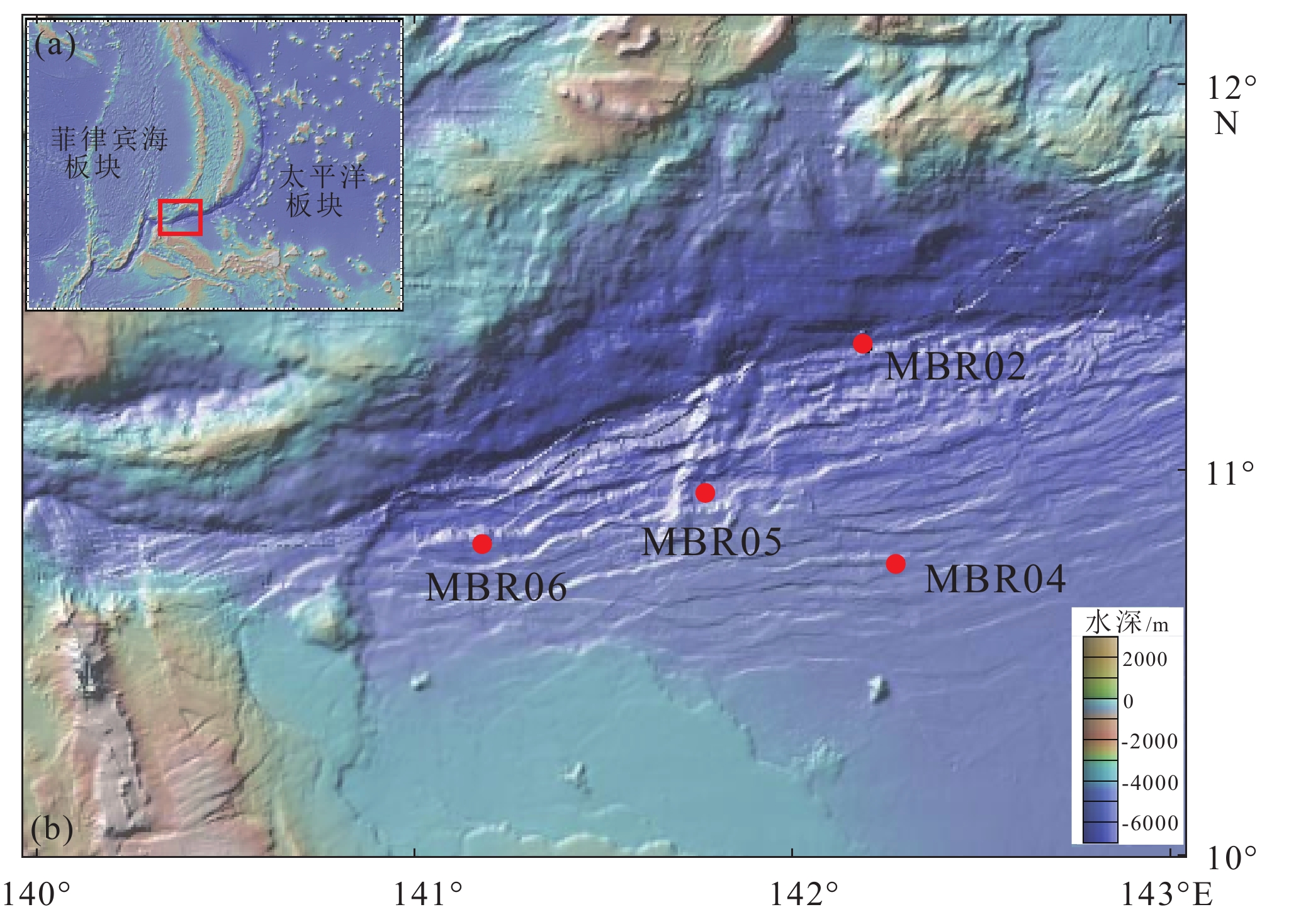
 下载:
下载:
